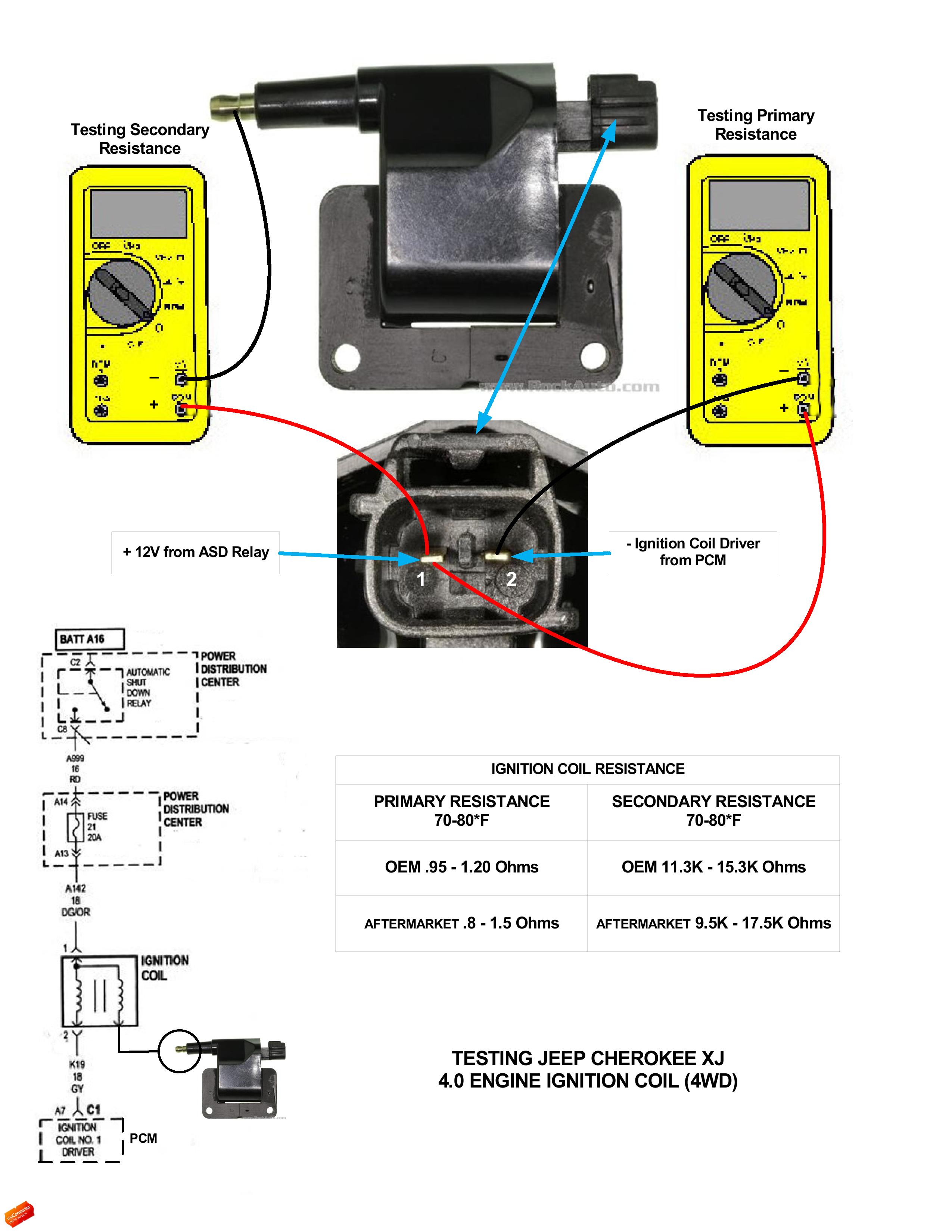Cherokee General Info. (Codes & Parts *4/12/23)
#46
CF Veteran
Join Date: Aug 2010
Location: Canton, MI
Posts: 8,357
Likes: 0
Received 82 Likes
on
67 Posts
Year: 1999
Model: Cherokee
Engine: 4.0
Below is a guide for the 1988-1996 and 1997-2001 Cherokee XJ AW4 transmission oil cooler plumbing.
1988-1996:

.
1997-2001:
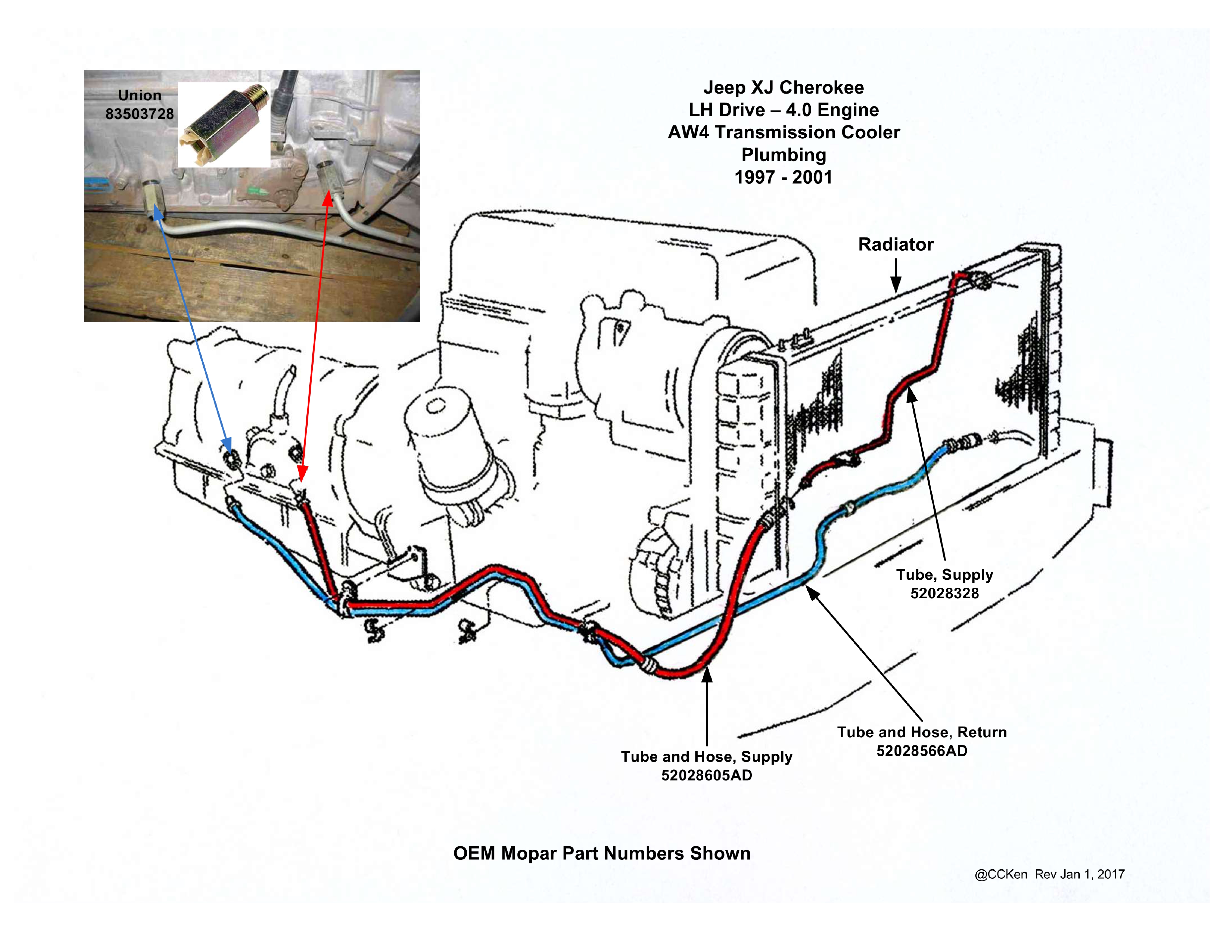
1988-1996:

.
1997-2001:

Last edited by CCKen; 02-15-2017 at 08:10 AM.
#47
CF Veteran
Join Date: Aug 2010
Location: Canton, MI
Posts: 8,357
Likes: 0
Received 82 Likes
on
67 Posts
Year: 1999
Model: Cherokee
Engine: 4.0
Here's a wiring schematic for the 1997 - 2001 XJ HVAC Blower:
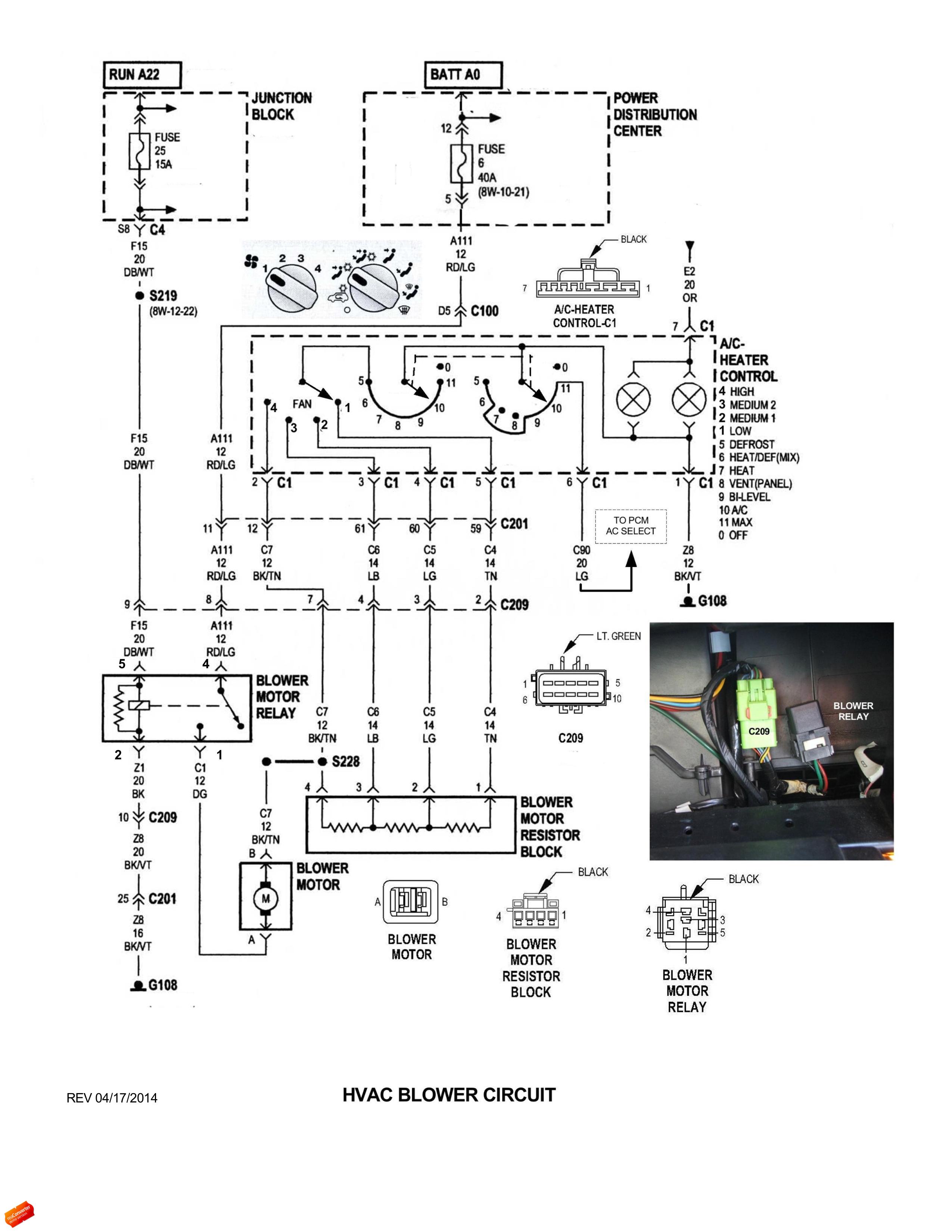
A wiring schematic for the 1999-2001 XJ Blend Air Door circuit.
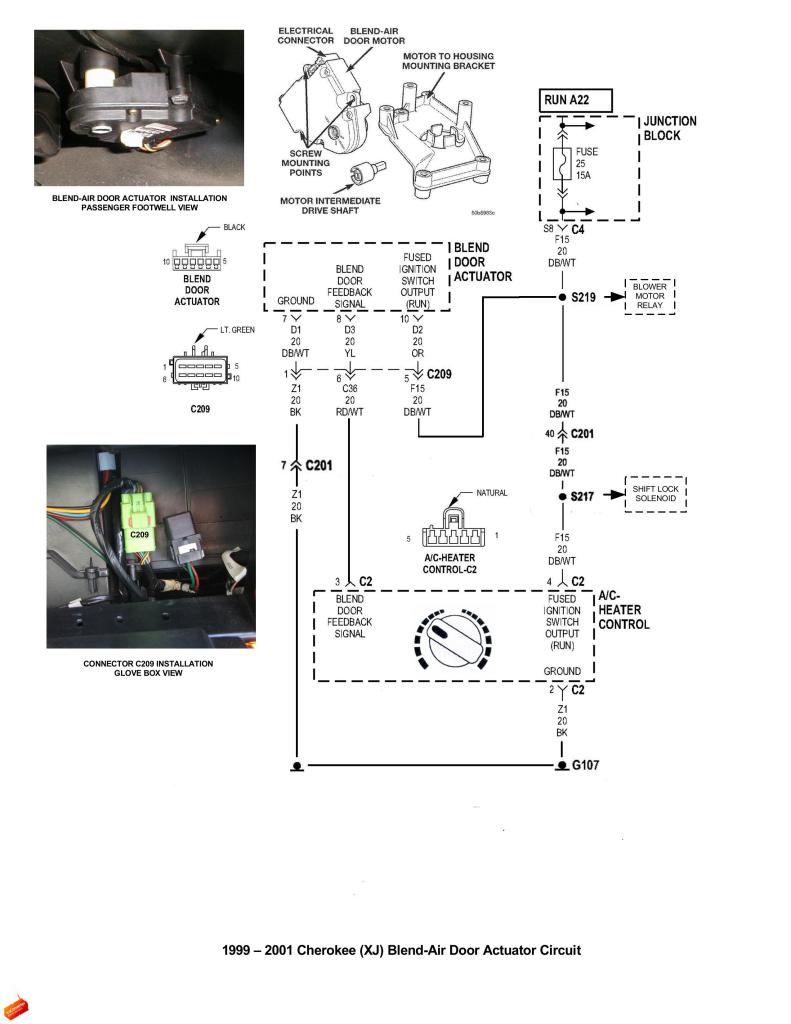

A wiring schematic for the 1999-2001 XJ Blend Air Door circuit.

Last edited by CCKen; 09-30-2014 at 06:06 AM.
#48
CF Veteran
Join Date: Aug 2010
Location: Canton, MI
Posts: 8,357
Likes: 0
Received 82 Likes
on
67 Posts
Year: 1999
Model: Cherokee
Engine: 4.0
This is not a How To post. Just some data for those interested in installing a temperature sensor for a temp gauge to monitor their AW4 fluid temperature.
This data applies to AW4 transmissions up to 1997. AW4 transmissions, starting in 1998, had the transmission case redesigned to accomodate an Input Speed Sensor, and in the process deleted the port described below.
The A340 transmission had/has a port on the transmission for a temperature sensor installation (see pic below). The pre-1998 AW4 transmissions has the same port but was not used for a temp sensor in the Jeep installations.
Page from a Toyota Tacoma manual showing the temp sensor location:
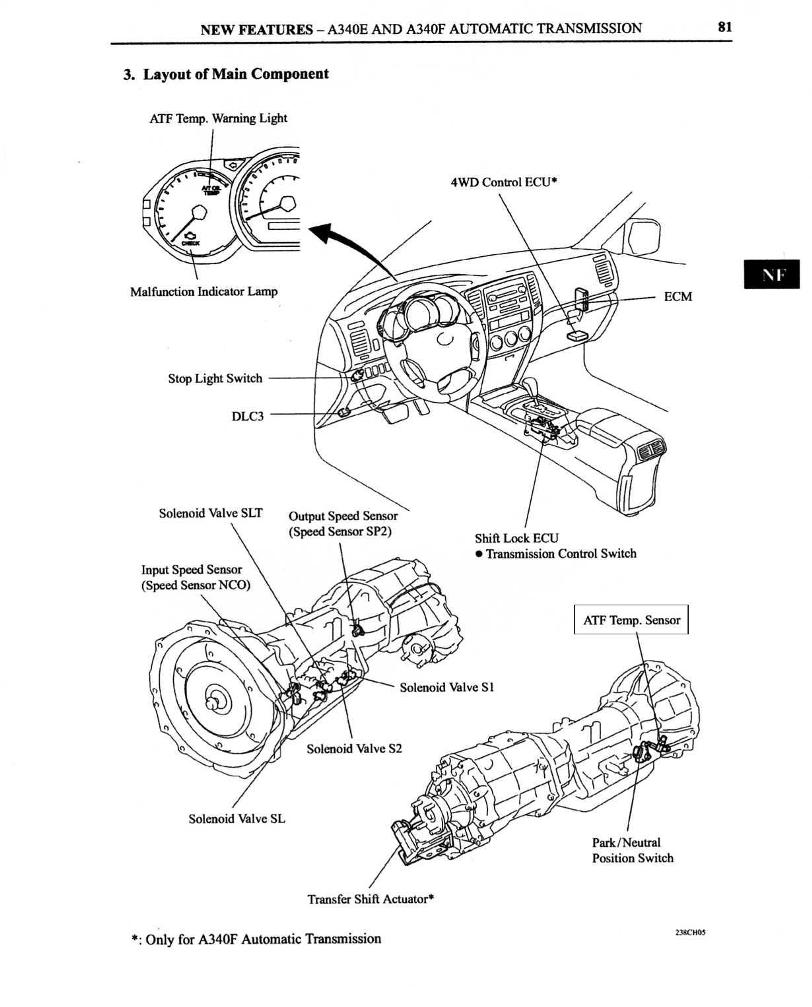
The temp sensor port blanked out on a '98+ AW4:
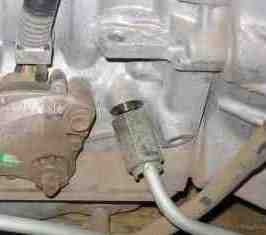
Temp sensor port plug incorporated in the pre-'98 AW4:
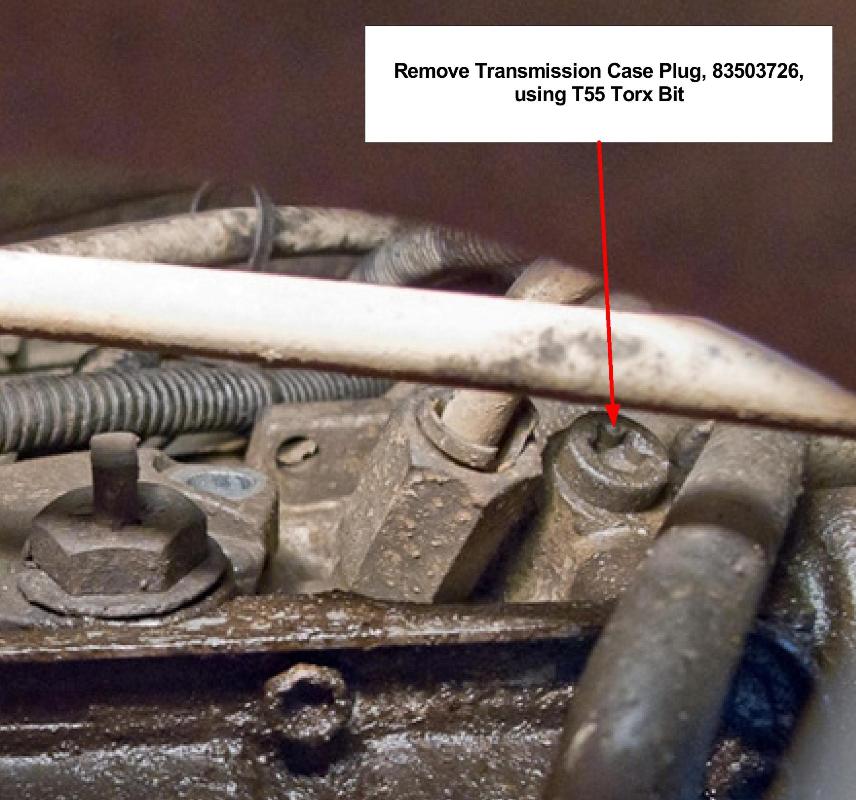
Temp sensor Metric adaptor for installation of a temp sensor:
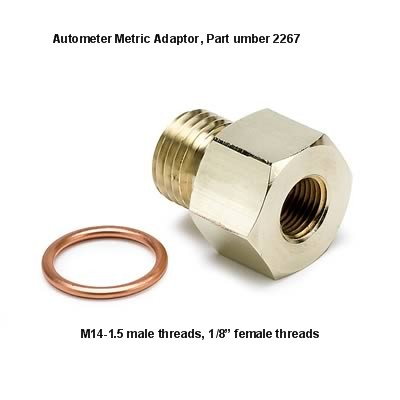
Installation of the Metric adaptor and the temp sensor:
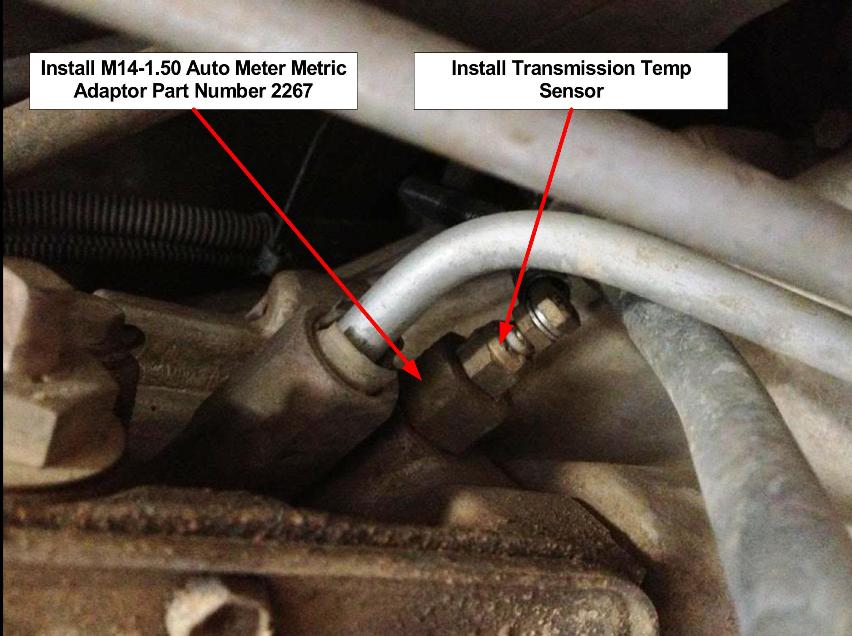
Pic of the temp sensor installation is from a thread on NAXJA.
This data applies to AW4 transmissions up to 1997. AW4 transmissions, starting in 1998, had the transmission case redesigned to accomodate an Input Speed Sensor, and in the process deleted the port described below.
The A340 transmission had/has a port on the transmission for a temperature sensor installation (see pic below). The pre-1998 AW4 transmissions has the same port but was not used for a temp sensor in the Jeep installations.
Page from a Toyota Tacoma manual showing the temp sensor location:

The temp sensor port blanked out on a '98+ AW4:

Temp sensor port plug incorporated in the pre-'98 AW4:

Temp sensor Metric adaptor for installation of a temp sensor:

Installation of the Metric adaptor and the temp sensor:

Pic of the temp sensor installation is from a thread on NAXJA.
#49
CF Veteran
Join Date: Aug 2010
Location: Canton, MI
Posts: 8,357
Likes: 0
Received 82 Likes
on
67 Posts
Year: 1999
Model: Cherokee
Engine: 4.0
Guide to the location of the 1997-2001 ground points.
Engine Bay grounds:
G100. Main battery to chassis ground.
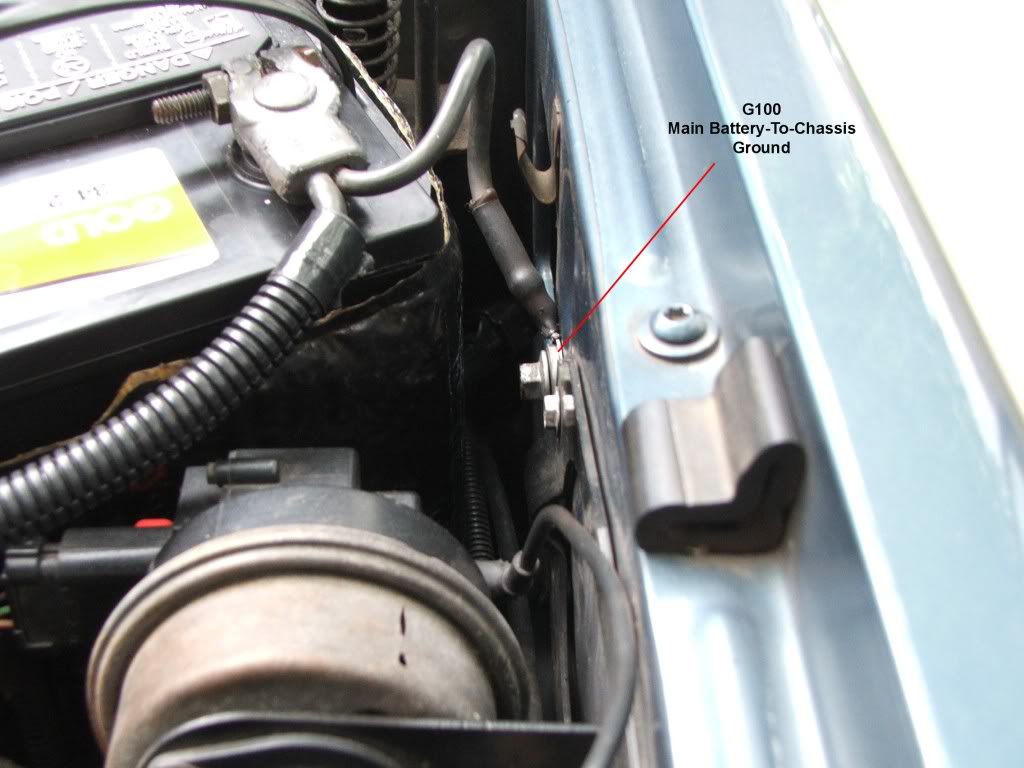
G100 Rear view from inside of the right wheel well. Accessed by removing the right wheel well liner.
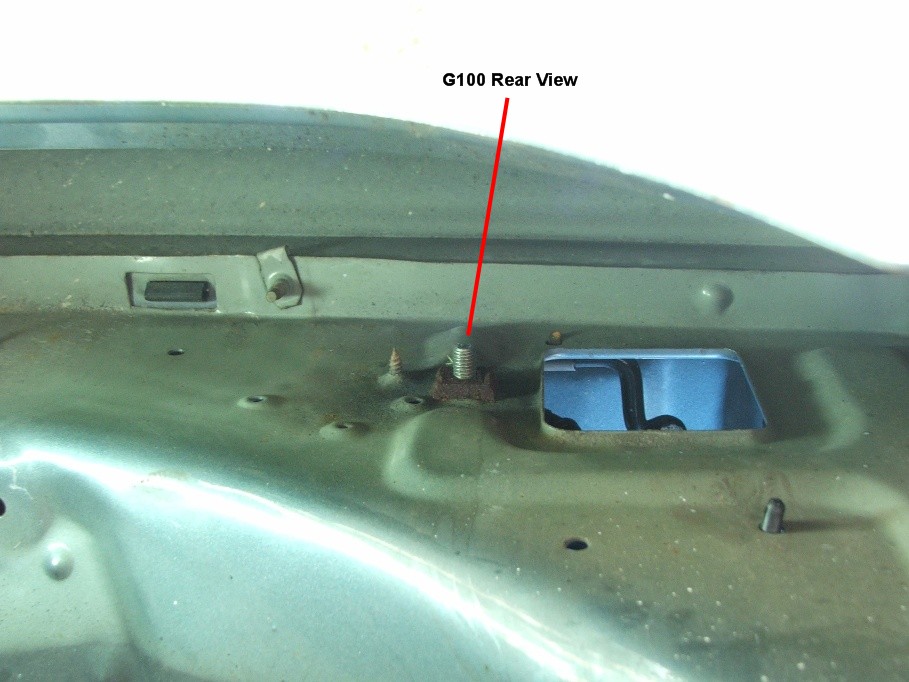
G101. 1997-1999 Ignition Coil shown. 2000 and 2001 at same location.
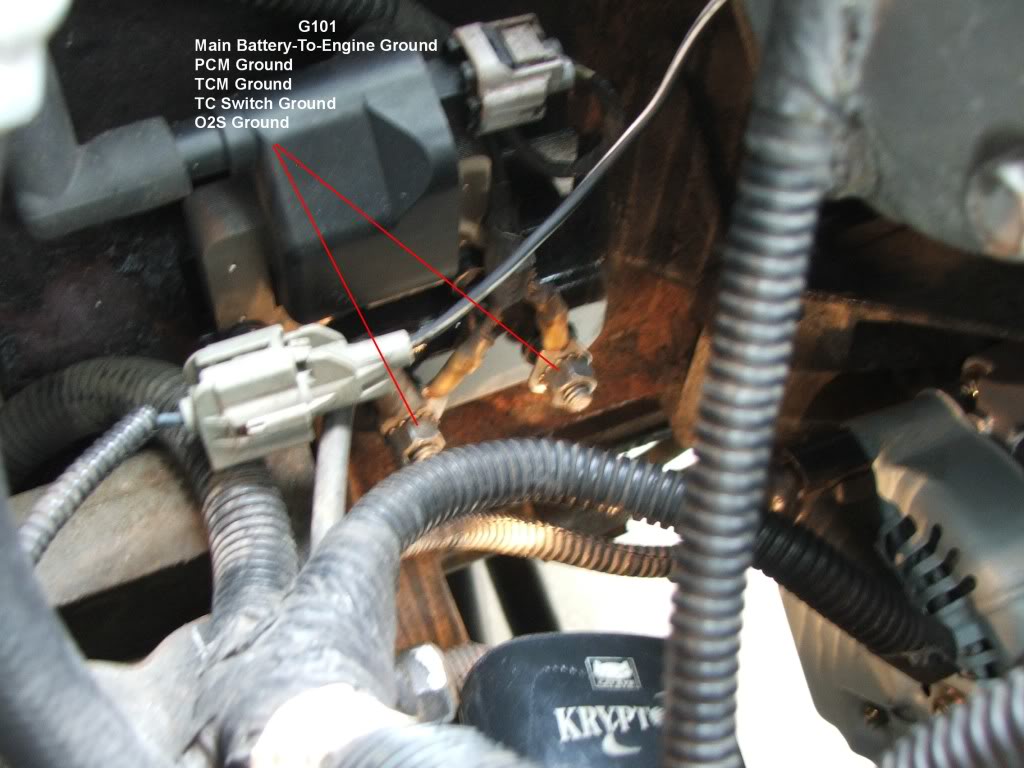
G102. Ground for Data Link Connector pin cavities 4 and 5. Located at the oil dipstick tube attach bracket stud.
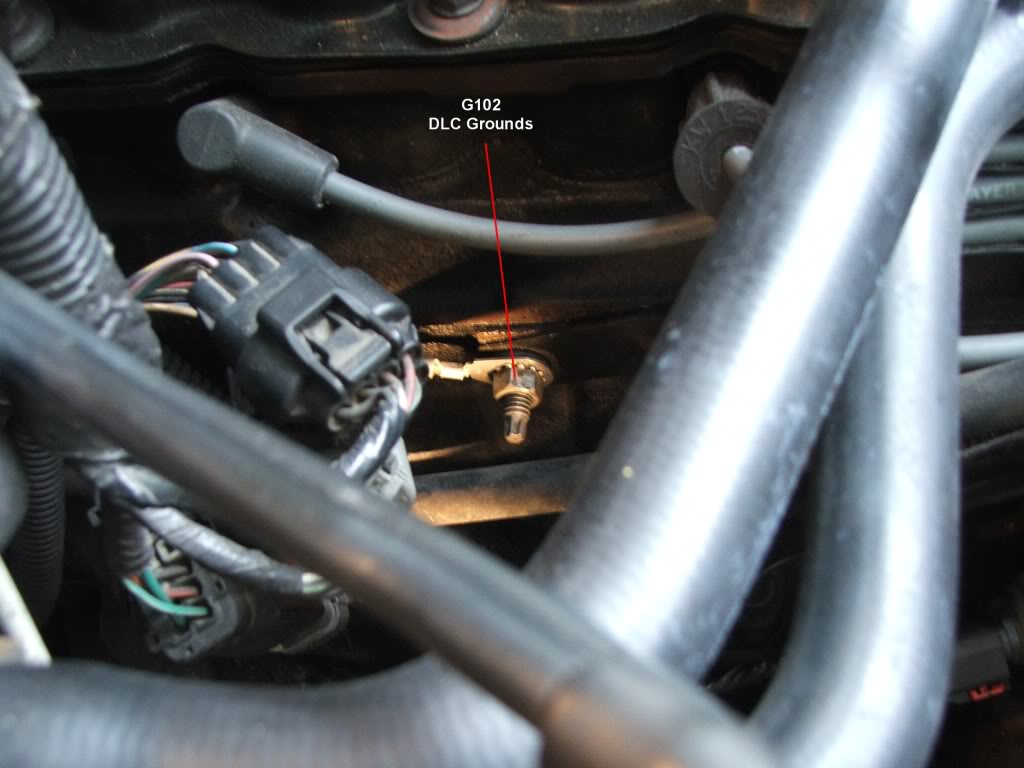
G106. Located on left inner fender by the PCM and Air Filter box.
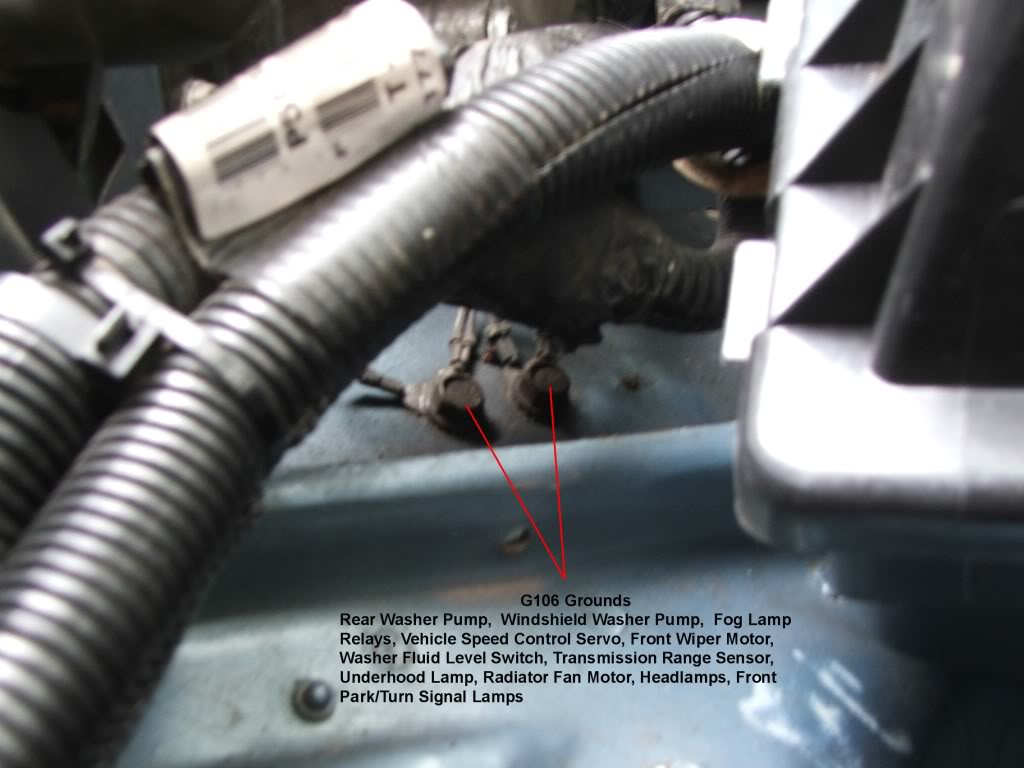
Firewall radio interferance noise suppression bonding strap.
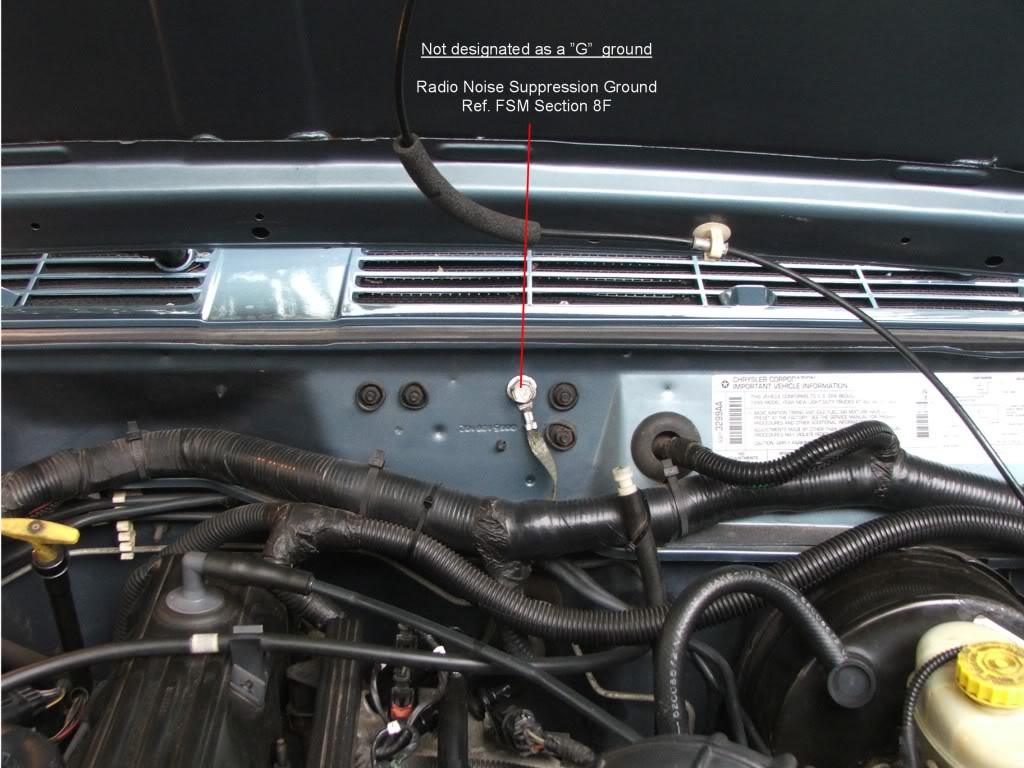
Firewall bonding strap connection on cylinder head bolt stud. Double nut configuration shown.
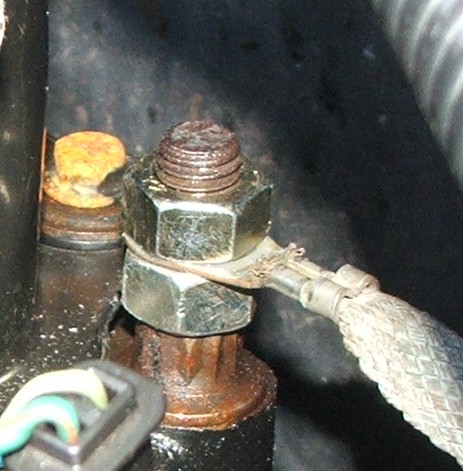
Cargo Bay grounds:
Located behind the spare tire mount bracket.
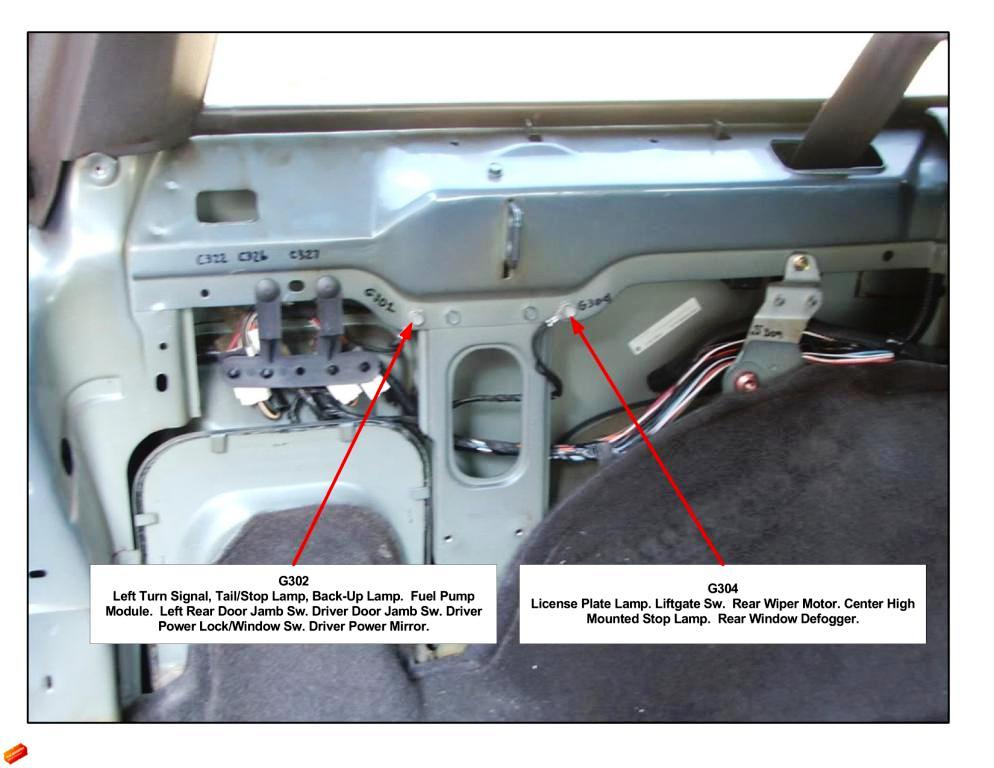
.
Another view of G101 with different connections:
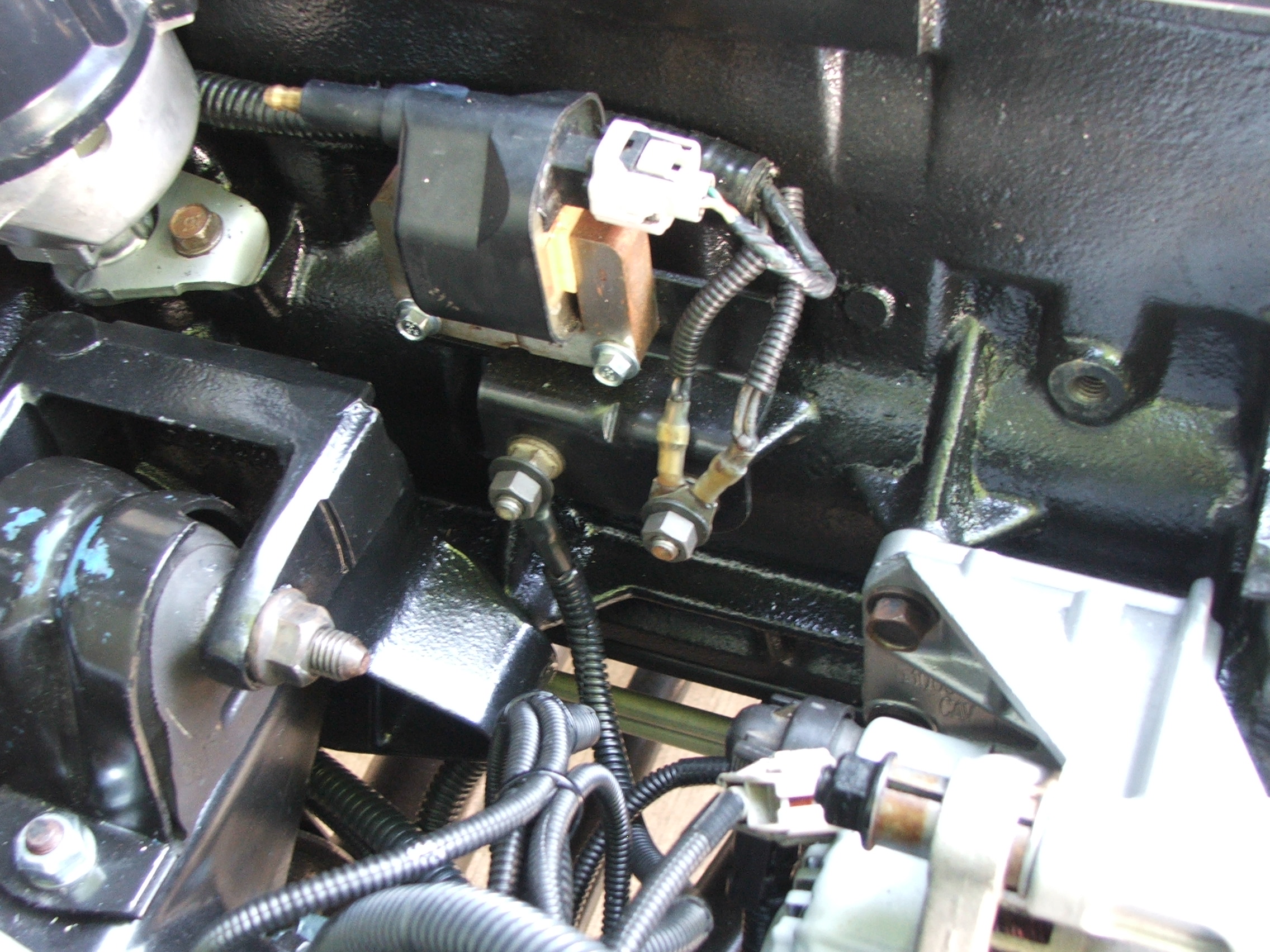
.
Engine Bay grounds:
G100. Main battery to chassis ground.

G100 Rear view from inside of the right wheel well. Accessed by removing the right wheel well liner.

G101. 1997-1999 Ignition Coil shown. 2000 and 2001 at same location.

G102. Ground for Data Link Connector pin cavities 4 and 5. Located at the oil dipstick tube attach bracket stud.

G106. Located on left inner fender by the PCM and Air Filter box.

Firewall radio interferance noise suppression bonding strap.

Firewall bonding strap connection on cylinder head bolt stud. Double nut configuration shown.

Cargo Bay grounds:
Located behind the spare tire mount bracket.

.
Another view of G101 with different connections:

.
Last edited by CCKen; 03-18-2015 at 08:09 AM.
The following users liked this post:
NWPenCrawler (06-10-2020)
#50
CF Veteran
Join Date: Aug 2010
Location: Canton, MI
Posts: 8,357
Likes: 0
Received 82 Likes
on
67 Posts
Year: 1999
Model: Cherokee
Engine: 4.0
If anyone is looking for a Chrysler Sales Code, go to this list and look it up. For each code it gives a brief explanation what the code includes.
http://www.lxforums.com/articles/salescode.pdf
http://www.lxforums.com/articles/salescode.pdf
#51
CF Veteran
Join Date: Aug 2010
Location: Canton, MI
Posts: 8,357
Likes: 0
Received 82 Likes
on
67 Posts
Year: 1999
Model: Cherokee
Engine: 4.0
Illustrations of the engine bay HVAC/Cruise Control vacuum system.
Engine bay vacuum diagram:
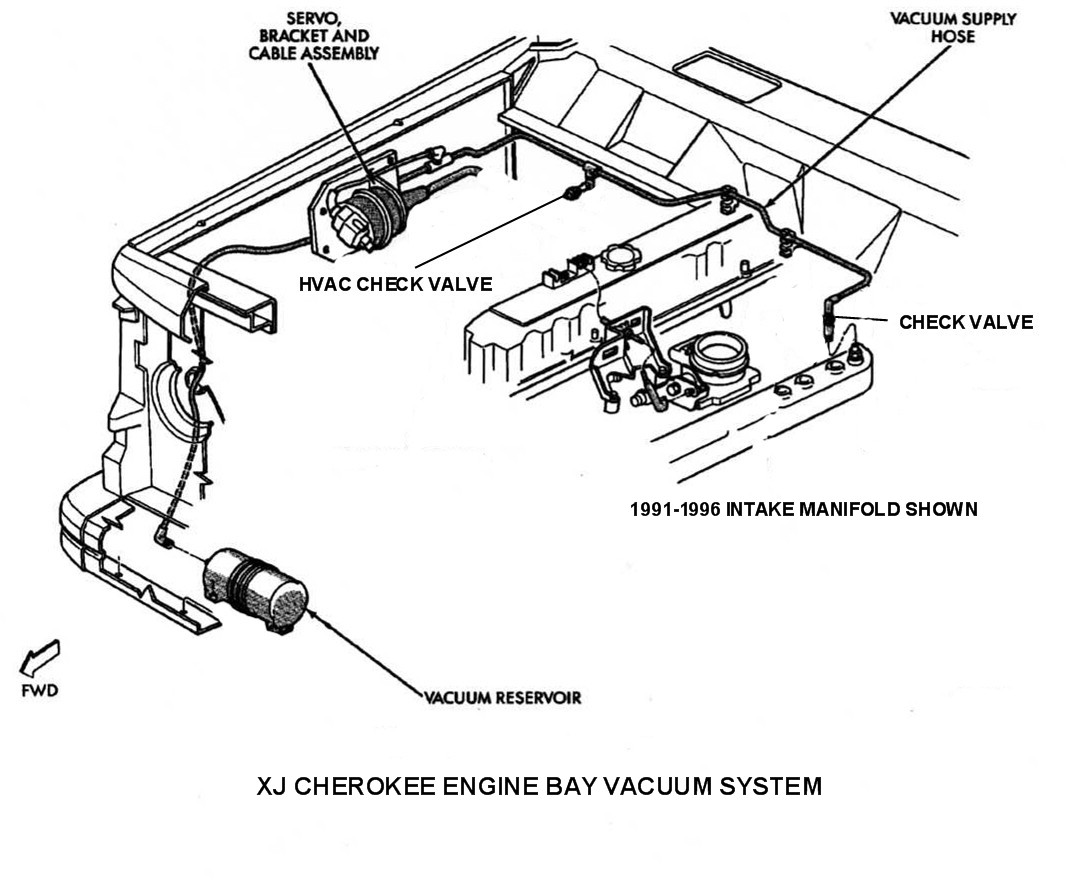
HVAC/Cruise Control Vacuum Reservoir (Typical 97-01 XJ):
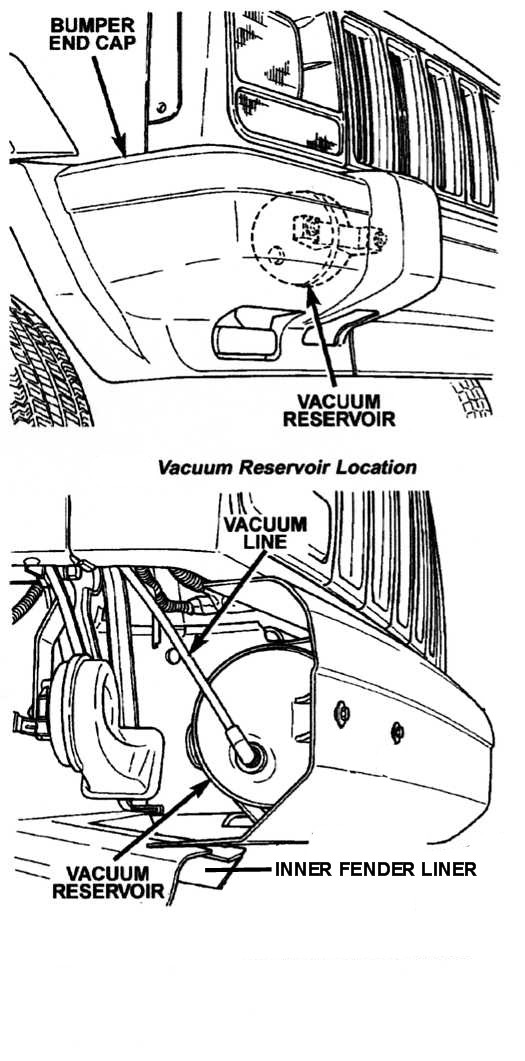
'99 Vacuum Reservoir Installation:
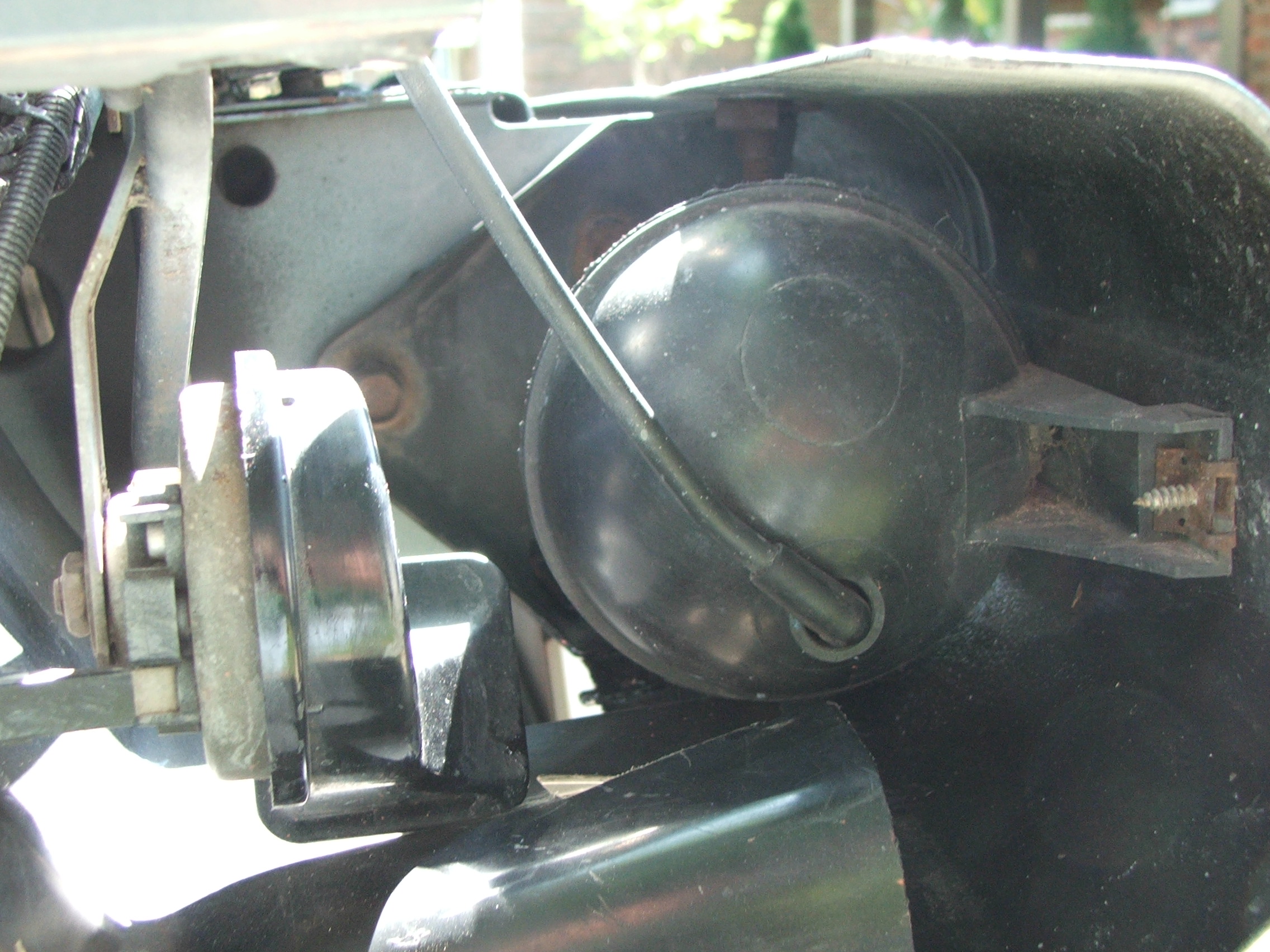
Vacuum Reservoir 91-96, 88-90 similar:
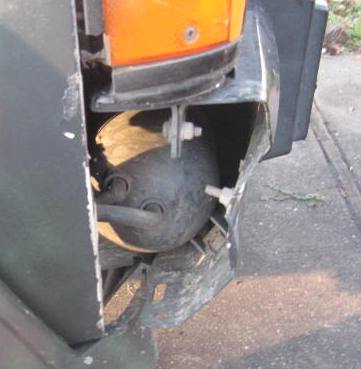
Vacuum Reservoir '90/91 connections:
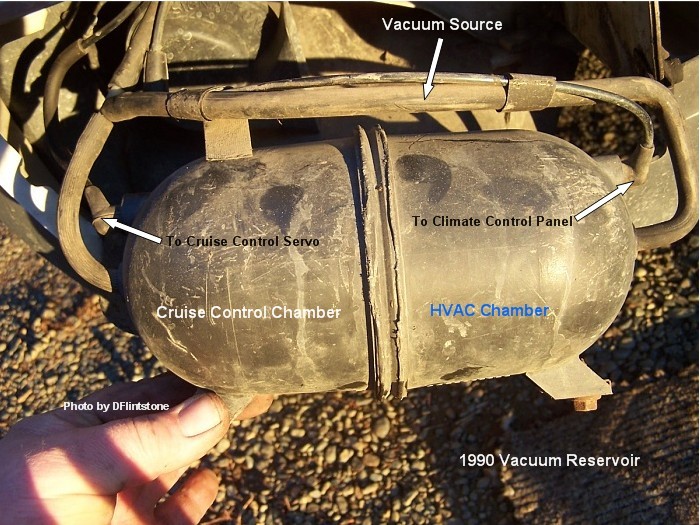
Vacuum source at intake manifold. Check valve shown:
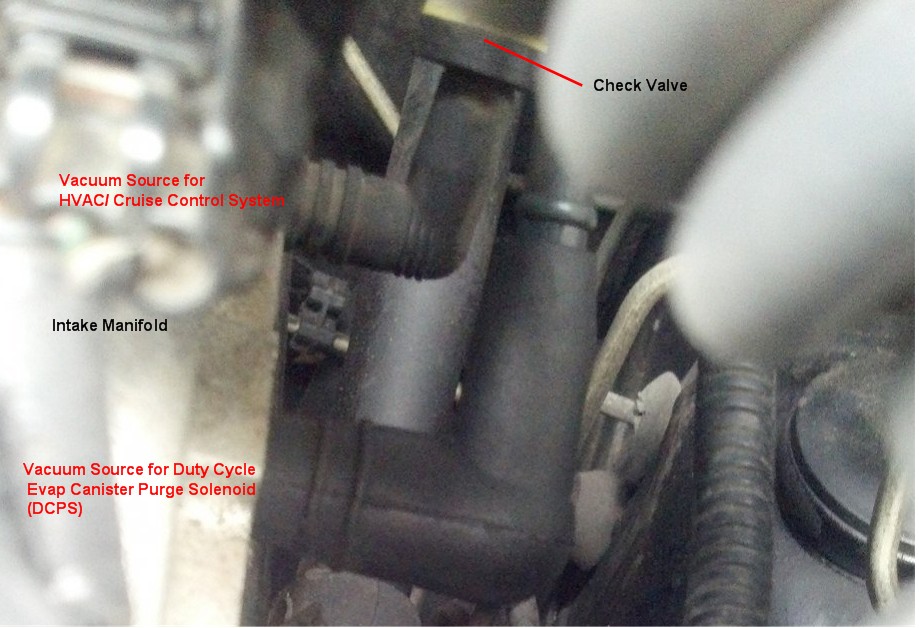
Another view of the check valve:
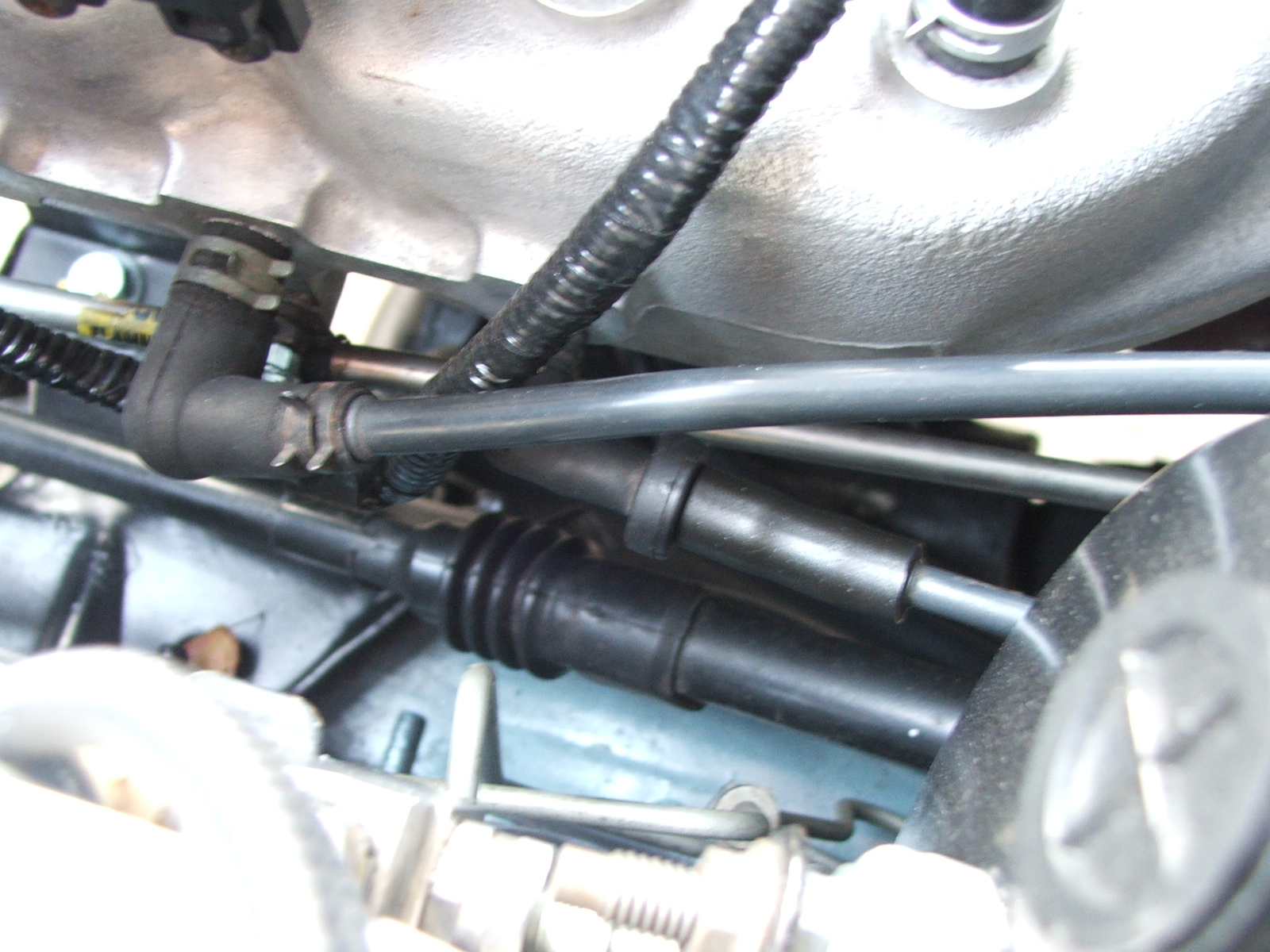
Area round Brake Booster subject to tube damage:
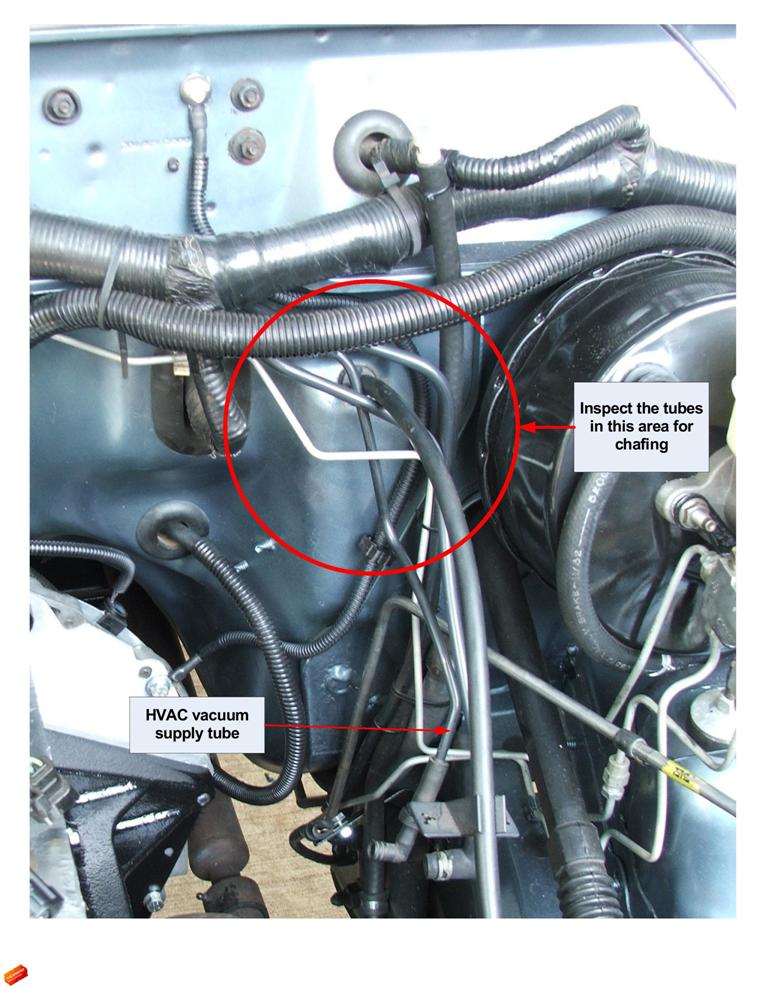
HVAC Check Valve:
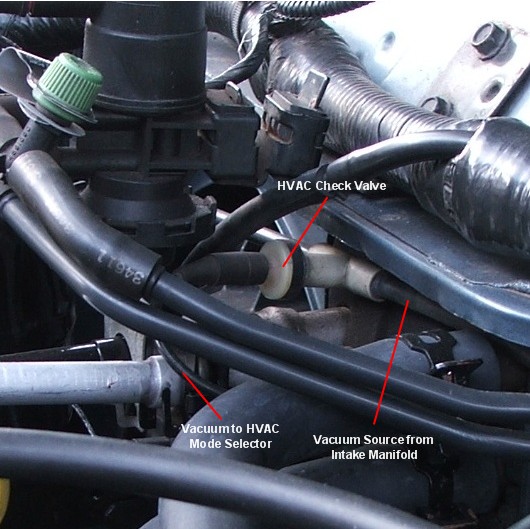
View of broken HVAC Check Valve source tube:
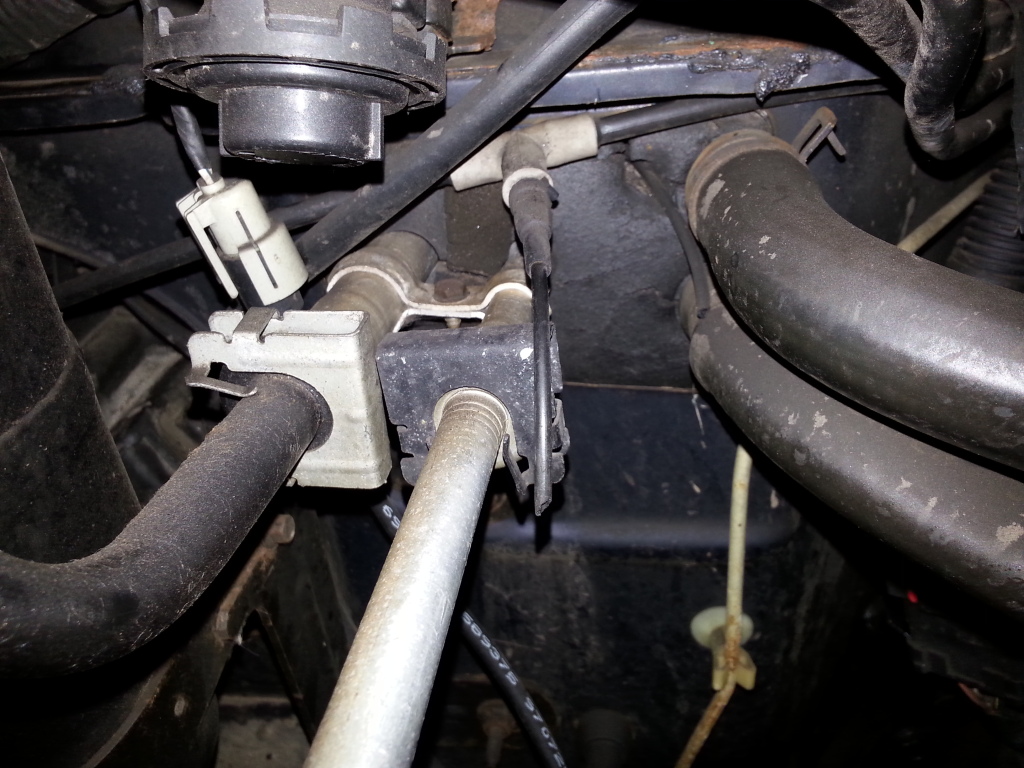
A fix for the broken HVAC Check Valve tube:
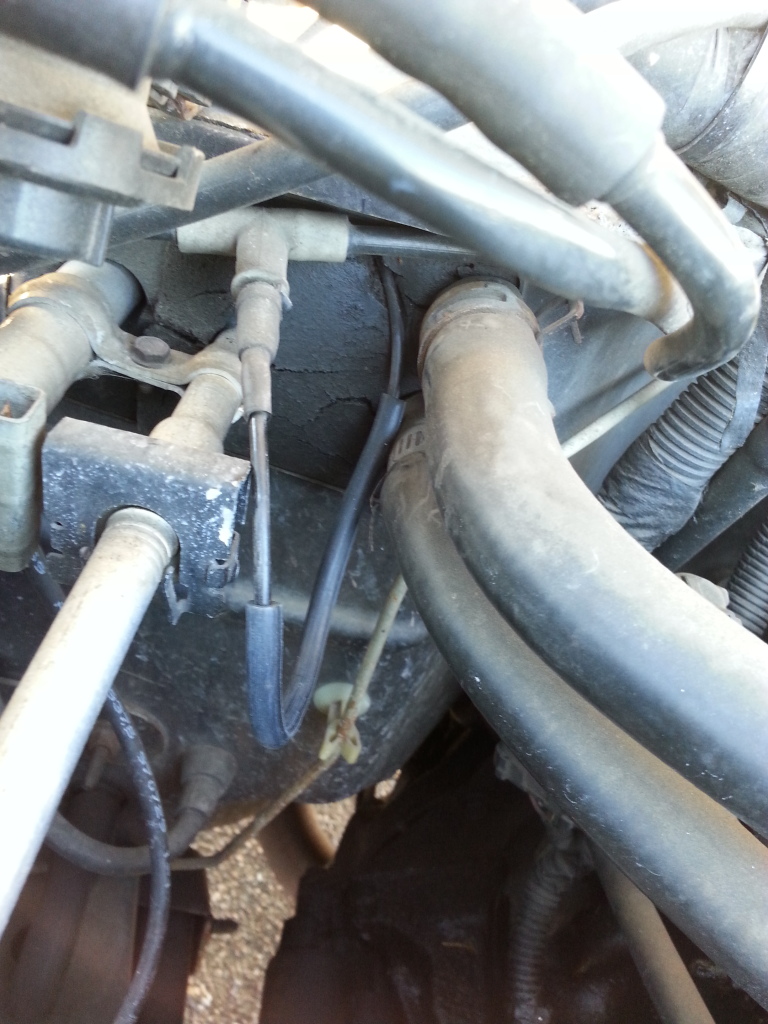
Area around Cruise Control Servo subject to tube damage:
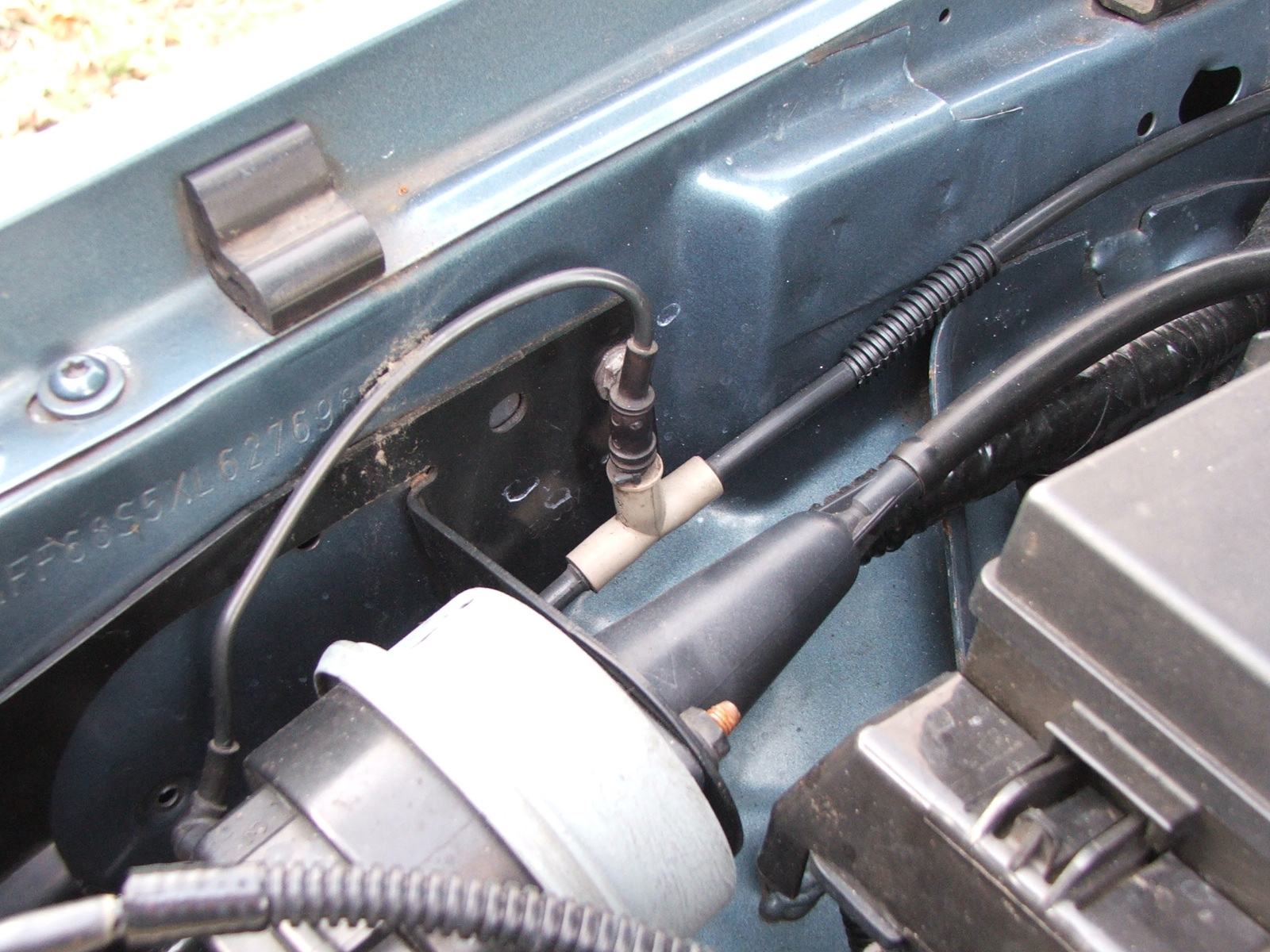
Another view of the Servo area. Includes area behind battery that tubing has been found damaged:
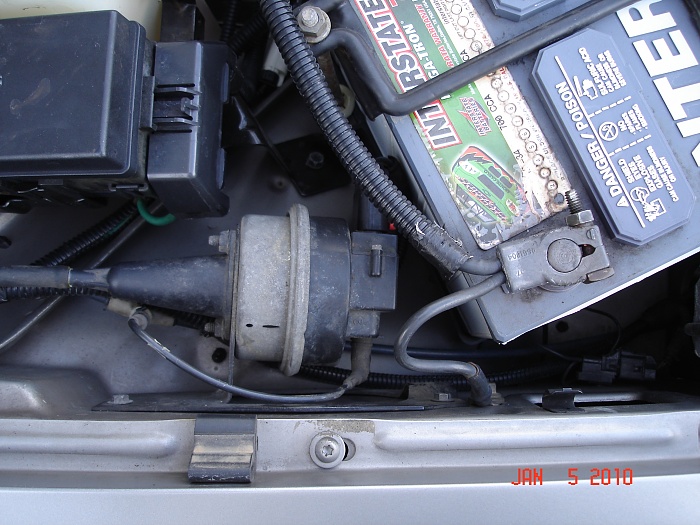
View of vacuum hand pump hooked up to test the vacuum system:
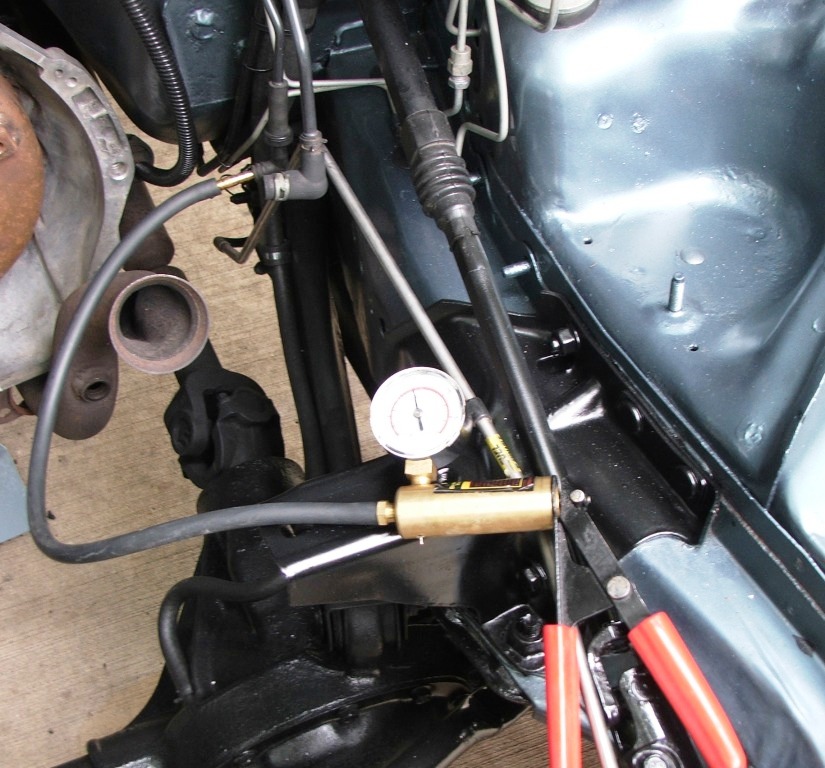
Engine bay vacuum diagram:

HVAC/Cruise Control Vacuum Reservoir (Typical 97-01 XJ):

'99 Vacuum Reservoir Installation:

Vacuum Reservoir 91-96, 88-90 similar:

Vacuum Reservoir '90/91 connections:

Vacuum source at intake manifold. Check valve shown:

Another view of the check valve:

Area round Brake Booster subject to tube damage:

HVAC Check Valve:

View of broken HVAC Check Valve source tube:

A fix for the broken HVAC Check Valve tube:

Area around Cruise Control Servo subject to tube damage:

Another view of the Servo area. Includes area behind battery that tubing has been found damaged:

View of vacuum hand pump hooked up to test the vacuum system:

Last edited by CCKen; 03-18-2015 at 08:21 AM.
#52
CF Veteran
Join Date: Aug 2010
Location: Canton, MI
Posts: 8,357
Likes: 0
Received 82 Likes
on
67 Posts
Year: 1999
Model: Cherokee
Engine: 4.0
Good thread concerning damaged wiring in the Liftgate (Tailgate) in the linked thread, started by blazinbob.
https://www.cherokeeforum.com/f2/tai...arness-164094/
https://www.cherokeeforum.com/f2/tai...arness-164094/
#53
CF Veteran
Join Date: Aug 2010
Location: Canton, MI
Posts: 8,357
Likes: 0
Received 82 Likes
on
67 Posts
Year: 1999
Model: Cherokee
Engine: 4.0
When doing electrical tests of sensors at their connectors, instrument cluster connectors, transmission control module connector, PCM connectors, etc., back probing or probing pin cavities is mentioned as the method.
The following is recommended for back probing and pin cavity probing.
Go to a fabric store and buy a varity pack of safety pins to use as probes.
Shown are the three safety pins to use.
#1 pin and #2 pin are used to probe pin cavities in connectors and #3 pin is used for back probing a connector.
Safety Pin Probes:
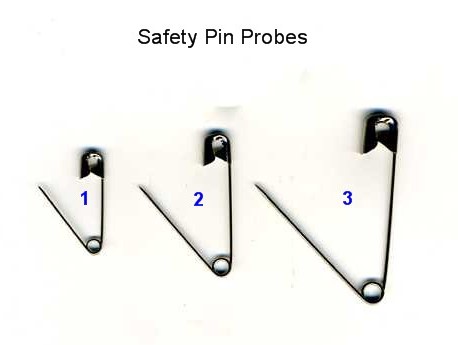
Example of back probing a connector using #3 pins:
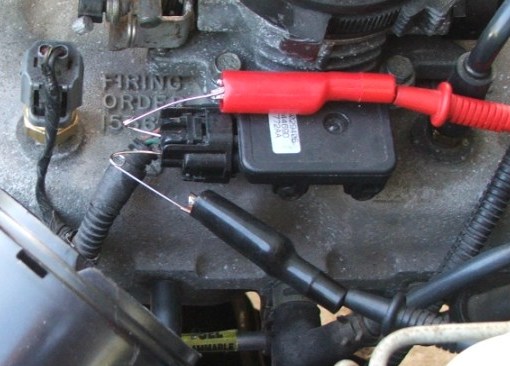
Example of probing pin cavities using #2 pins. #1 pins may be required for smaller pin cavities. Select the proper sze pin for the pin cavity.
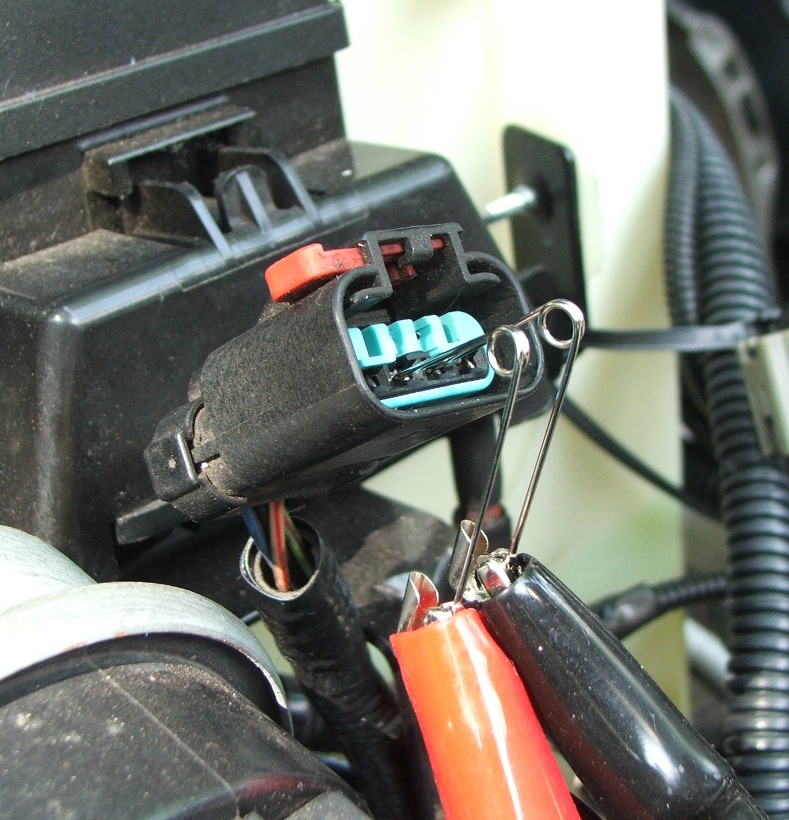
The following is recommended for back probing and pin cavity probing.
Go to a fabric store and buy a varity pack of safety pins to use as probes.
Shown are the three safety pins to use.
#1 pin and #2 pin are used to probe pin cavities in connectors and #3 pin is used for back probing a connector.
Safety Pin Probes:

Example of back probing a connector using #3 pins:

Example of probing pin cavities using #2 pins. #1 pins may be required for smaller pin cavities. Select the proper sze pin for the pin cavity.

#54
CF Veteran
Join Date: Aug 2010
Location: Canton, MI
Posts: 8,357
Likes: 0
Received 82 Likes
on
67 Posts
Year: 1999
Model: Cherokee
Engine: 4.0
This is the Felpro Torque Specs Guide for head bolts. The Guide lists head gaskets, bolts, and other Felpro products, as well as the torque specs.
Handy document.
pdf format.
http://www.felpro-only.com/tec_notes...rque-Guide.pdf
Handy document.
pdf format.
http://www.felpro-only.com/tec_notes...rque-Guide.pdf
#55
CF Veteran
Join Date: Aug 2010
Location: Canton, MI
Posts: 8,357
Likes: 0
Received 82 Likes
on
67 Posts
Year: 1999
Model: Cherokee
Engine: 4.0
Wiring diagrams for the 1988 XJ.
Really poor quality images but they may be of some value.
To view the images closer press and hold the "Ctrl" key on your key board while tapping your "+" key. Tap the "-" to return to normal size.
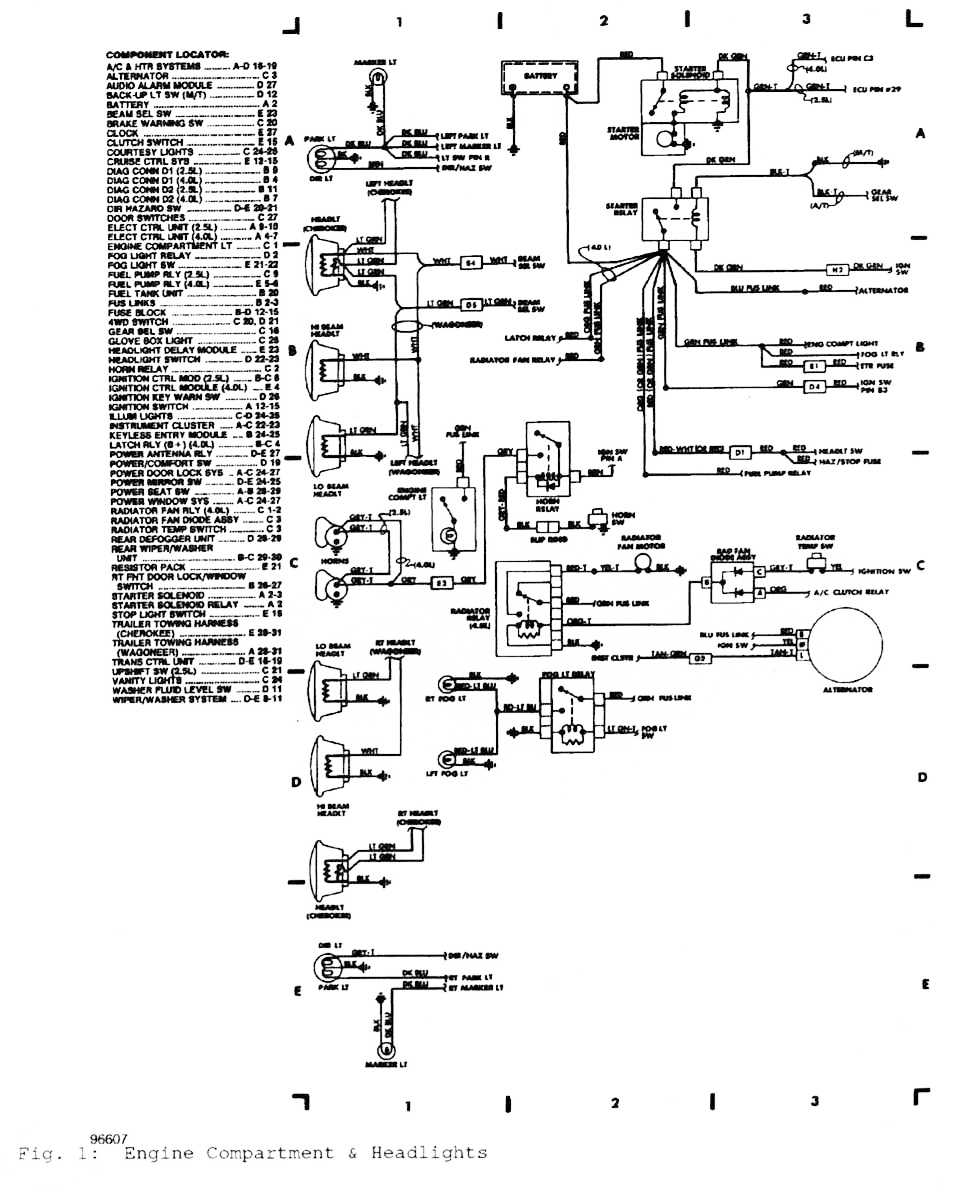
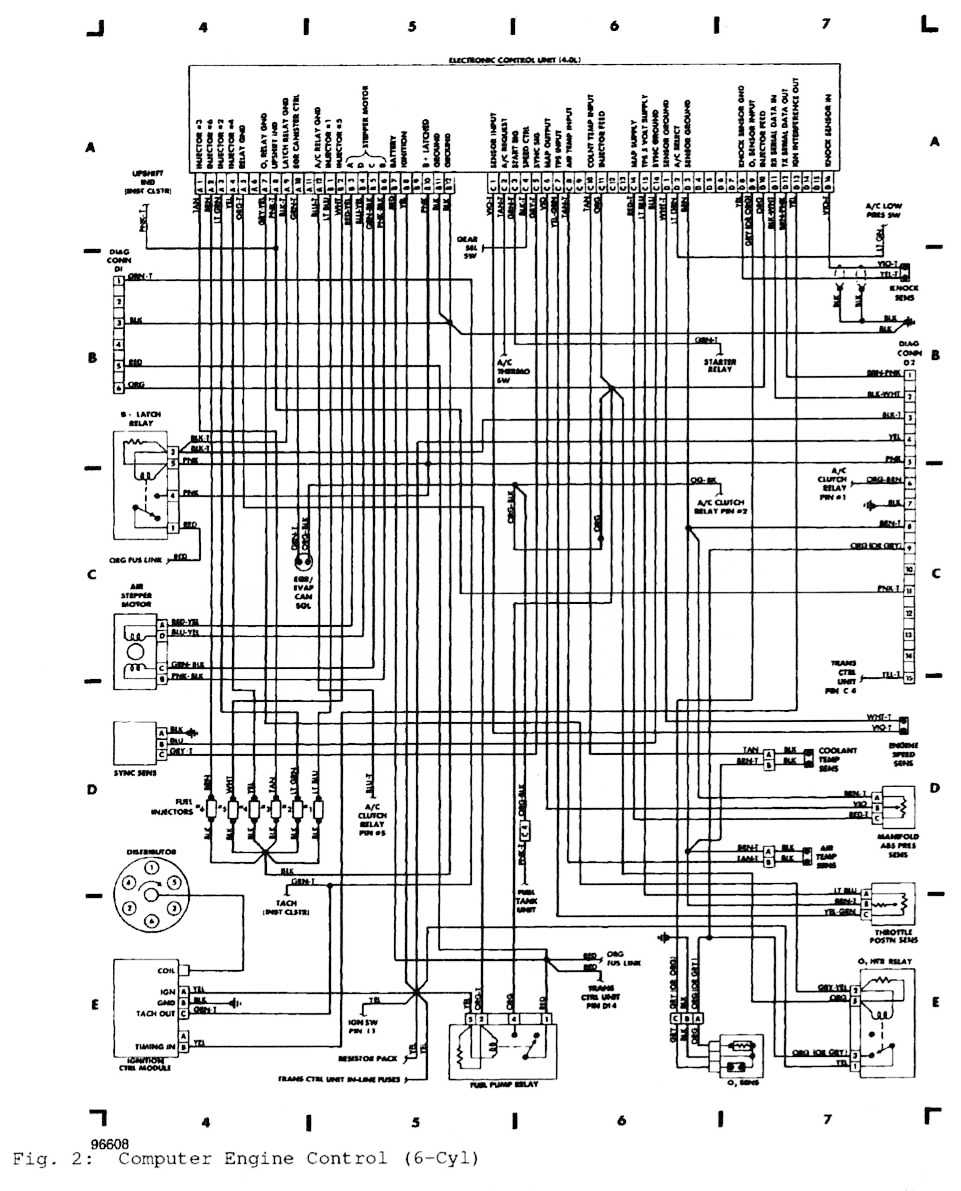
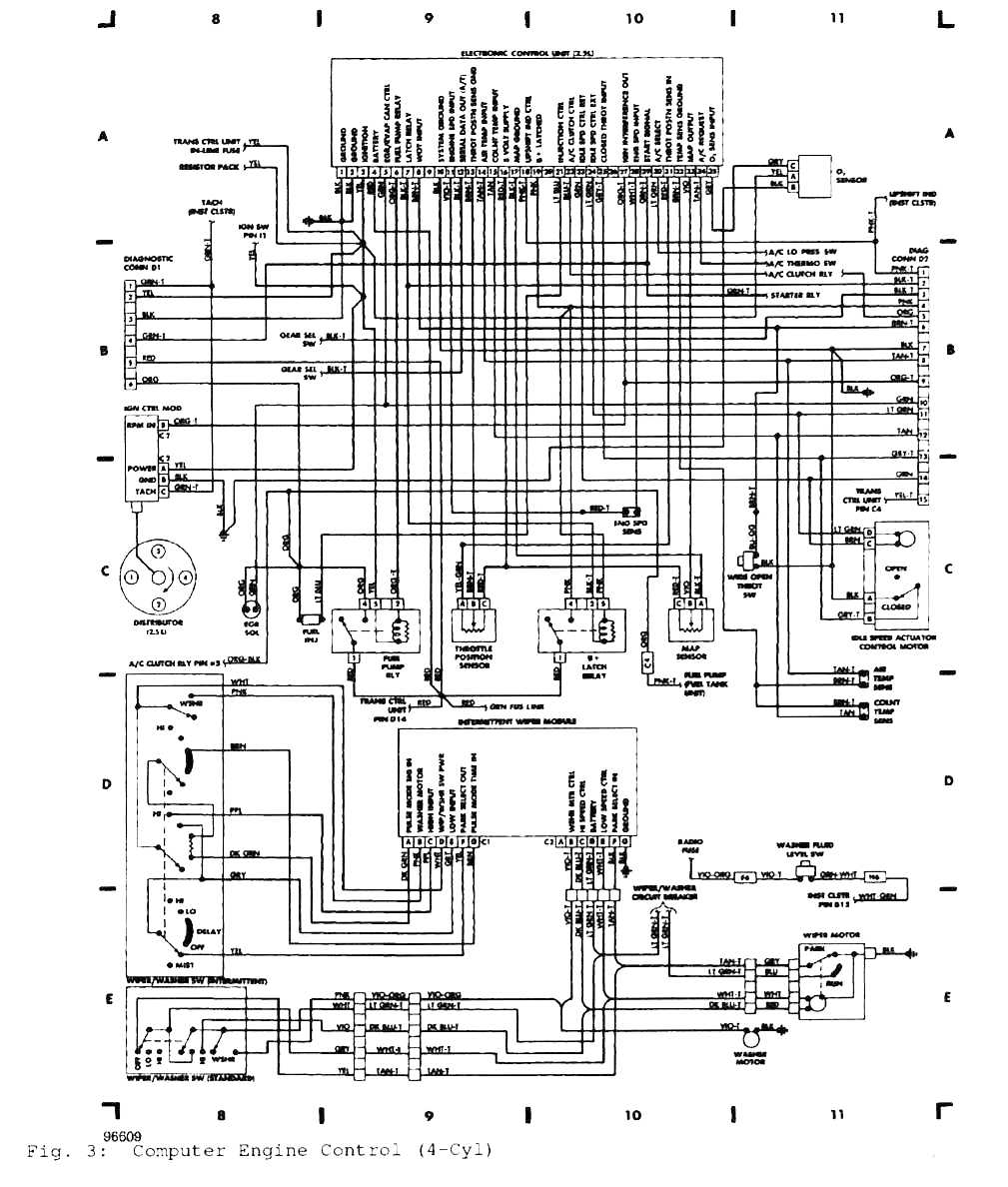
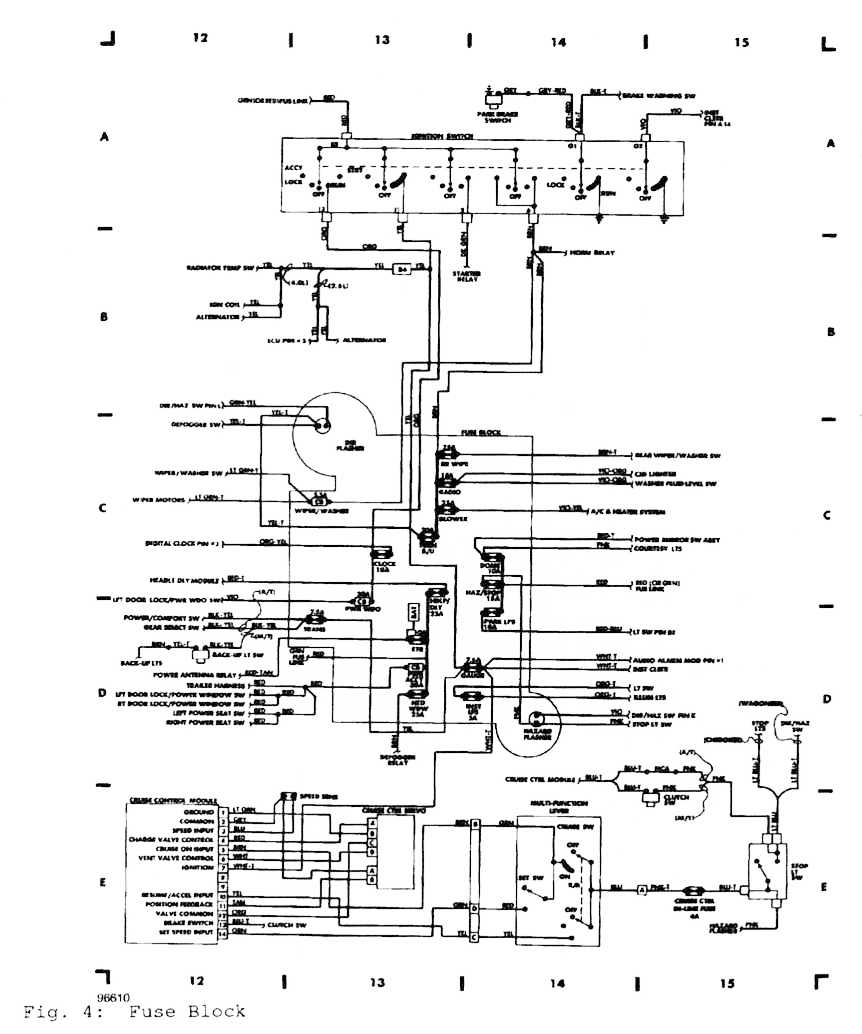
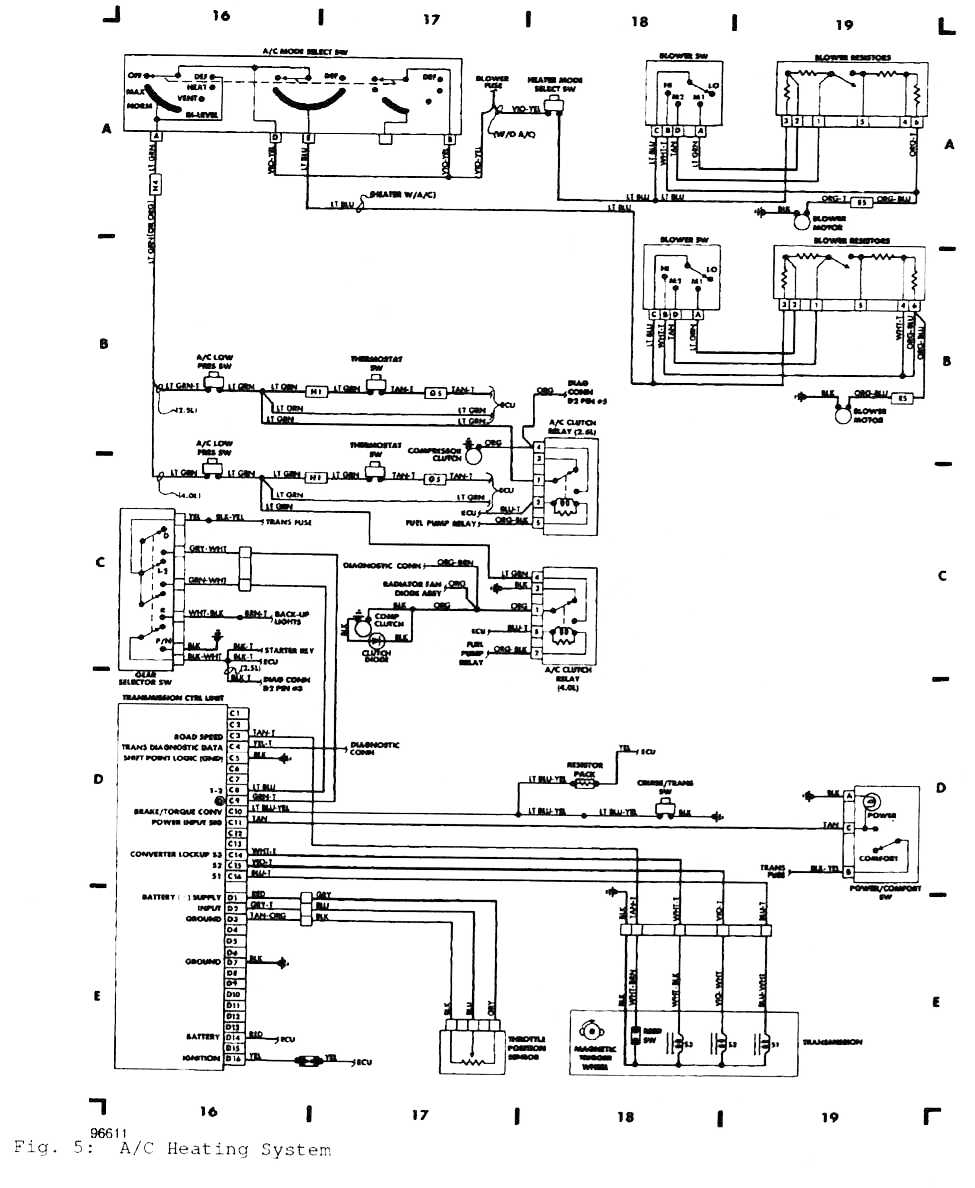
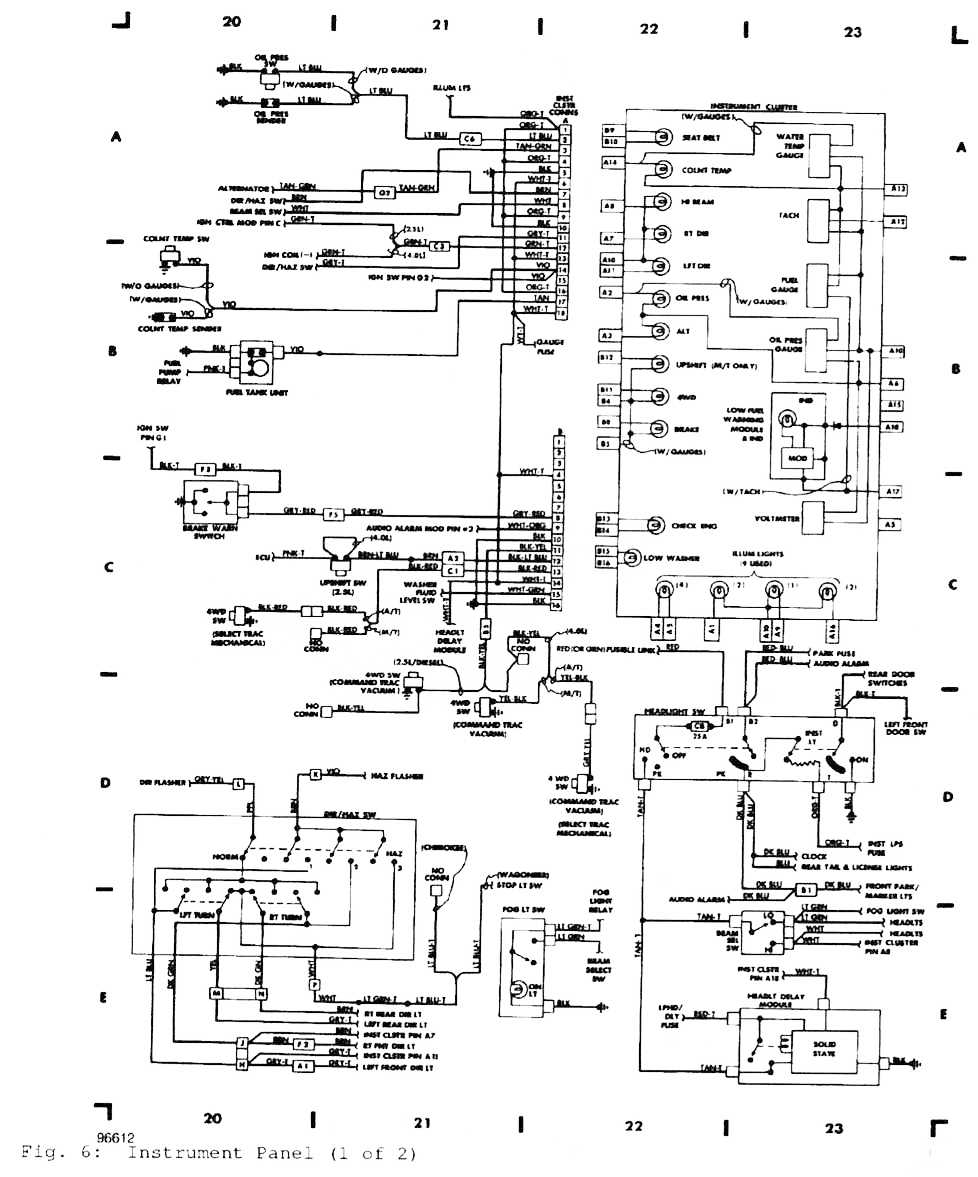
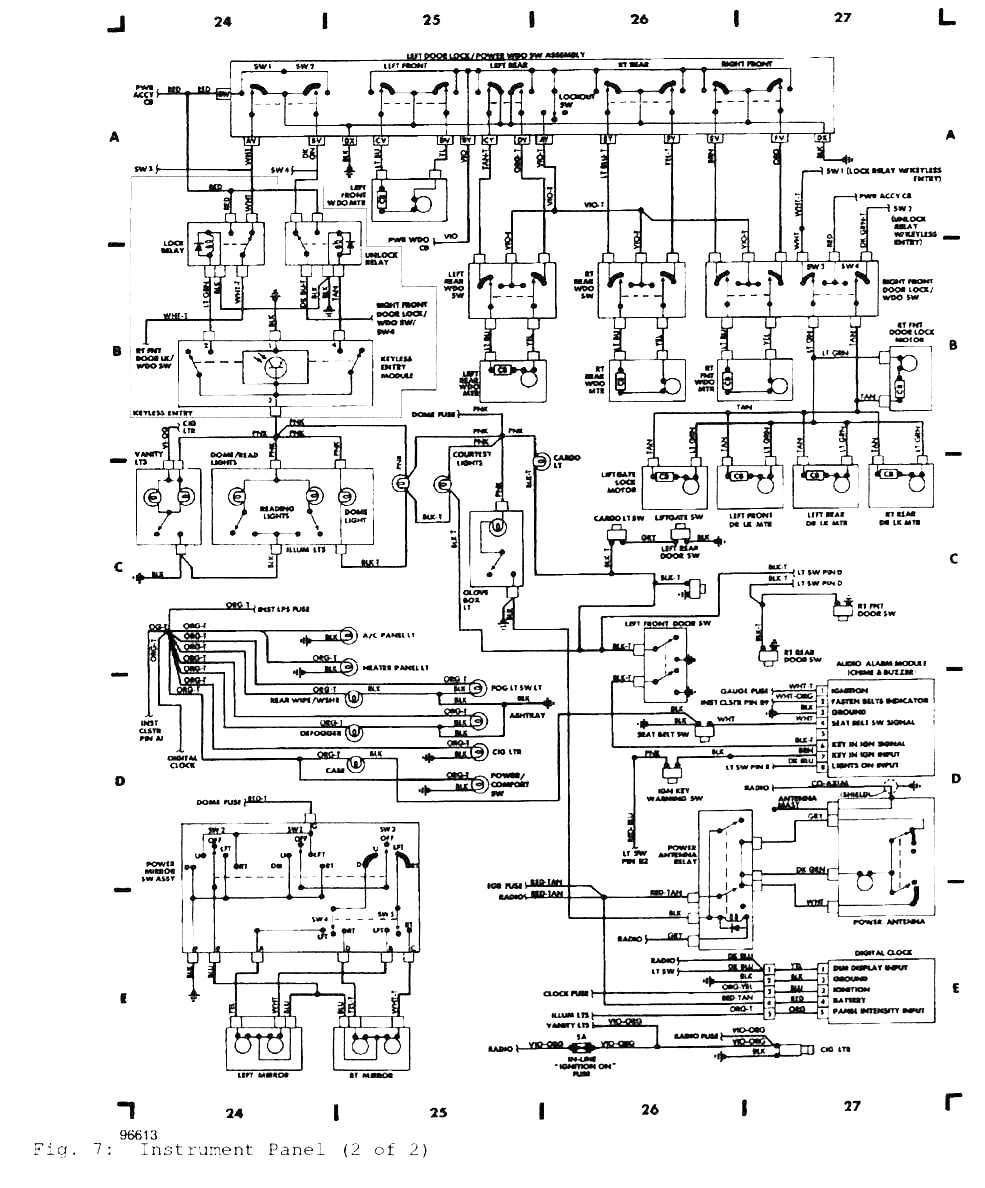
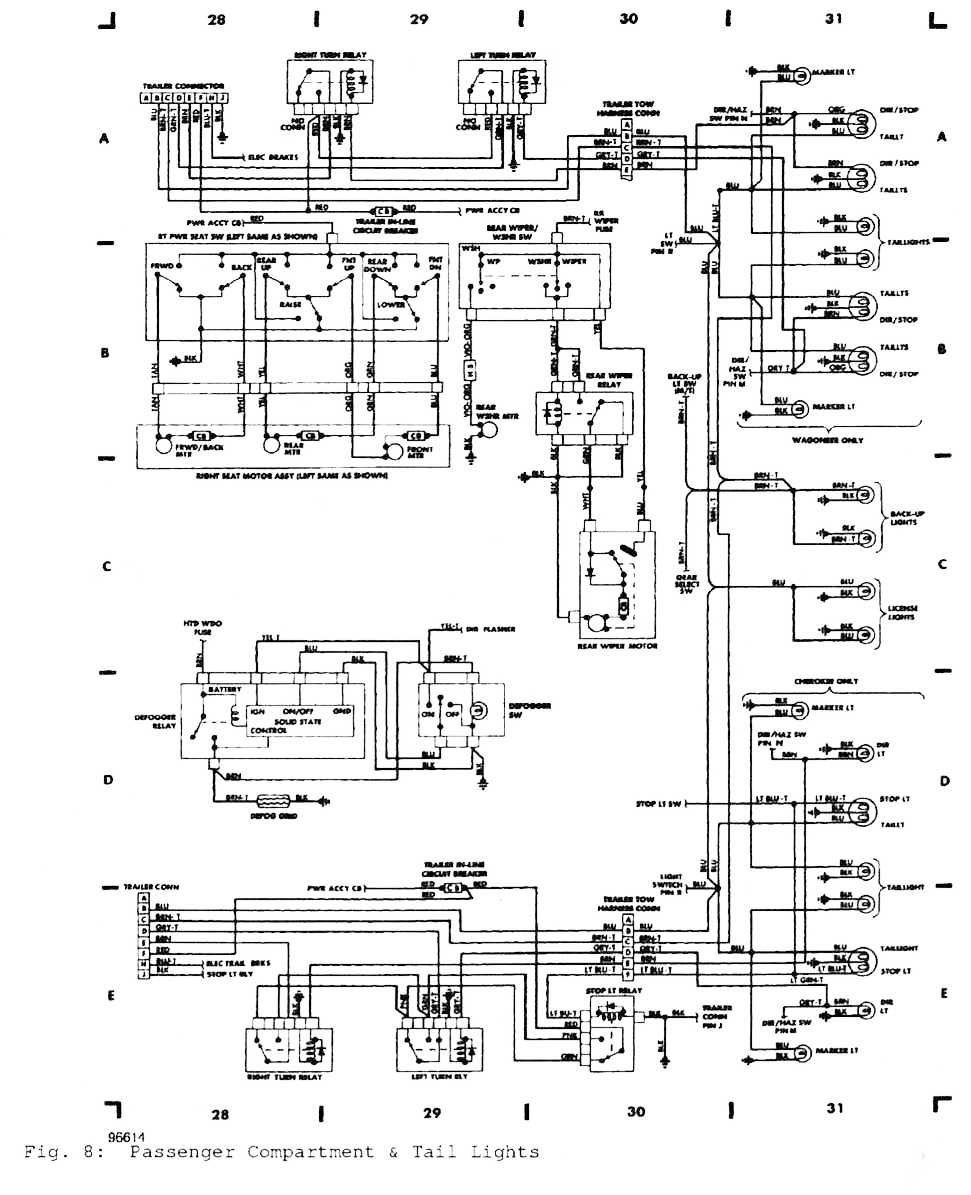
Really poor quality images but they may be of some value.
To view the images closer press and hold the "Ctrl" key on your key board while tapping your "+" key. Tap the "-" to return to normal size.








#56
CF Veteran
Join Date: Aug 2010
Location: Canton, MI
Posts: 8,357
Likes: 0
Received 82 Likes
on
67 Posts
Year: 1999
Model: Cherokee
Engine: 4.0
Ever had a part left over after putting your HVAC Unit back together and can't figure out where it should have gone?
Like this:
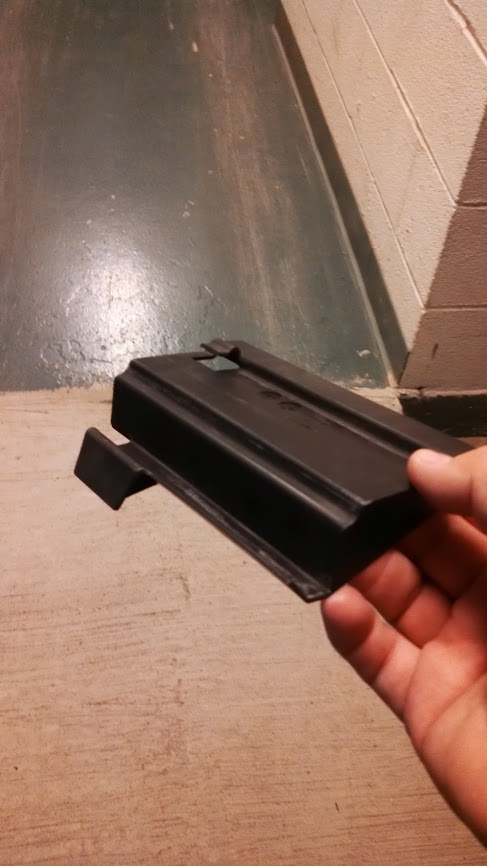
Well, here's where it goes - being installed:
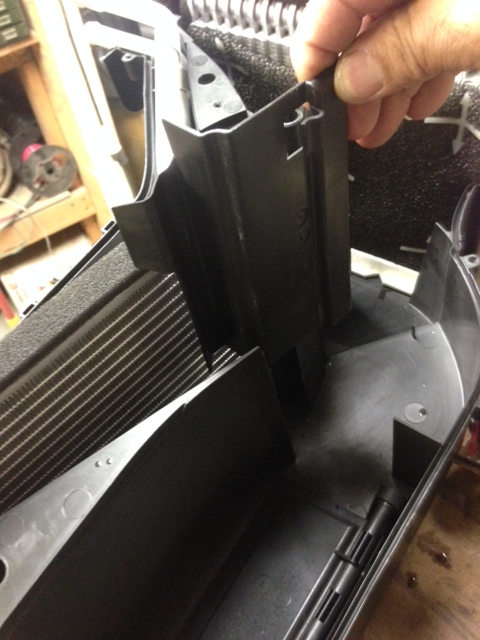
And, after being installed:
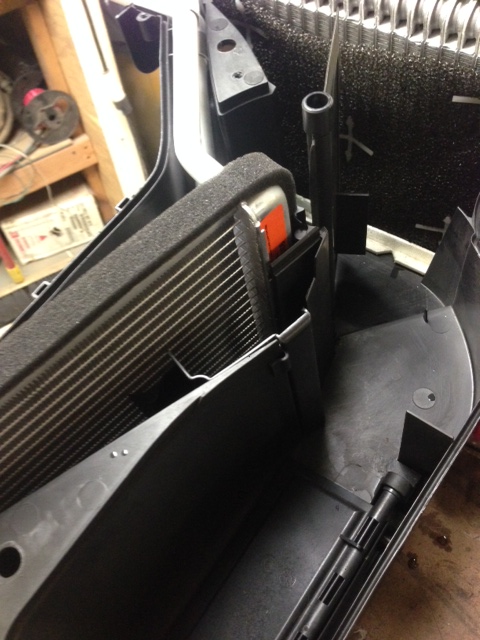
Cheers.
Like this:

Well, here's where it goes - being installed:

And, after being installed:

Cheers.
The following users liked this post:
XJ_Lady93 (11-14-2022)
#60
Junior Member
Join Date: Feb 2015
Location: US-MS
Posts: 32
Likes: 0
Received 1 Like
on
1 Post
Year: 1989
Model: Cherokee
Engine: 4.0L I6 "Power Tech"
This is actually my first post on the forum! I had an XJ in high school, and sold it because 1) I didn't know what I had 2) I thought I wanted a sports car ... Needless to say after a few years, I finally found and bought an 89 Laredo last week. I have been pouring over a lot of articles on this site to learn as much as I can about XJs to catch up on what I had missed out on. Anyway I was browsing google and ran across this gem from Cherokeetalk.com, and I haven't seen anything like it here so I figure I would share the find for people like me who are just now seriously getting into them. If it already exists or needs to be placed elsewhere I do apologize!
Introduction
This page will detail the stock specs of the Jeep Cherokee (XJ) which was produced between 1984 - 2001 in the United States. That is a remarkable 18 year lifespan in which 2,884,172 Jeep Cherokees rolled off the assembly line! Originally designed and built by AMC, Chrysler continued the same design when they bought AMC in 1987. Anyways, the Cherokee was the icon of compact SUVs which led to a market full of those who tried to imitate it. Now the term "SUV" doesn't really mean a rugged vehicle that actually performs off the pavement, but the Cherokee remains one of the best "utility" 4x4s ever made.
On to the specs. The information here should be of some help in identifying what parts came with what year Cherokee. I have made every effort to make sure this information is correct by comparing data from a variety of sources. If you notice any errors or have additional information to contribute, please contact me by PM or e-mail.
The information on this page will be listed in the following order:
Common Design
Dimensions
Body
Engines
Transmissions
Transfer Cases
Driveshafts
Axles
Gearing
Cooling System
Airbags
Production Numbers
Trim Levels
Common Design
All XJs were built as a "Unibody" design with the body and frame rails tied together as one piece as opposed to a body on frame design. All XJs have solid axles front and rear. The suspension consists of coils for the front and leaf springs for the rear. All XJs came with disc brakes in the front and drums in the rear.
Dimensions
(small differences may occur depending on optional equipment or trim level)
wheelbase = 101.4"
overall length = 165.3" - 168.8"
overall width = 67.9" - 70.5"
track = 58"
height = 64"
height with roof rack = 66.8"
ground clearance (from differentials) = 7.3" - 8.3"
approach angle = 37.6* - 38*
departure angle = 31* - 32.1*
breakover angle = 21* - 21.9*
curb weight 2wd = 2,891 lbs - 2,993 lbs
curb weight 4wd = 3,057 lbs - 3,386 lbs
cargo capacity = 71.0 cu ft.
Body
The body comes in both 2-door and 4-door styles with a rear hatch (liftgate).
In 94 side-impact beams were added in the doors and roof was strengthened. The 3rd brakelight was added to the top of the liftgate.
In 96 the body structure was strengthened some although it was not noticeable in appearance.
In 97 the body (and interior) was redesigned to freshen it up a bit. Most noticeably it gave the body smoother lines by changing the bumpers, flares, and moldings. The front fender was trimmed just below the headlights and replaced with plastic bumper endcaps that wrap around to the wheel well. The liftgate was also changed from fiberglass to sheet metal in this year. The windshield washer bottle was also moved to the inside of the drivers side front fender.
Engines
2.5L I4 carburated - 105 hp @ 5000 rpm, 132 ft lb torque @ 2800 rpm - used in 84-85 models
2.5L I4 TBI (fuel injected) - 117 hp @ 5000 rpm, 135 ftlb @ 3500 rpm - used in 86 and updated in 87-90 to 121hp
2.5L I4 MPI (multi-port injection) - 130 hp @ 5250 rpm, 139 ft lb @ 3250 rpm - used in 91-00
GM 2.8L V6 - 115 hp @ 4800 rpm, 145 ft lb @ 2400 rpm - used in 84-86
Renault 2.1L 4cyl. Turbo Diesel - 85 hp @ 3750 rpm, 132 ft lb @ 2750 rpm - used in 85-87
Italian VM 2.5L Turbo Diesel - 140 hp, 236 ft lb torque - used in overseas XJs
4.0L I6 "Power Tech" - 177 hp @ 4750 rpm, 220 ft lb @ 4000 rpm - used 87-90
4.0L I6 MPI "Power Tech HO" (High Output) - 190 hp @ 4750 rpm, 220 ft lb @ 4,000 rpm - used in 91-95 and updated in 96-01 to 225 ft lb torque @ 3000 rpm (00-01 models use a distributorless ignition system)
Transmissions
Manual Transmissions
T4 or a T5 may have been used instead of an AX4 or an AX5 due to supply shortages.
AX4 - 4 speed manual - manufactured by Aisin - used 84-86 with 2.5L I4 and 2.8L V6 engines
AX5 - 5 speed manual - manufactured by Aisin - used with 2.8L V6 and 87+ with 2.5L I4
BA10/5 - 5 speed manual - manufactured by Peugot - used only up to 89
AX15 - 5 speed manual - manufactured by Aisin - used with 4.0L I6 engines
NV3550 - 5 speed manual - manufactured by New Venture - used in 00-01 in SE models with 4.0L I6 engines
Automatic Transmissions
Torqueflight 904 - 3 speed automatic - used 84-86 with 2.8L V6 engine and ?
30RH - 3 speed automatic - used with 2.5L I4 engine 94?-00
AW4 - 4 speed automatic, electronically controlled - manufactured by Aisin - used from 87-01 (87-91 models include a Power/Comfort button that adjusts the shift points)
Transfer Cases
The transfer cases used are all chain driven with aluminum housings. NP stands for "New Process" which is the brand, if you will. The newer ones are NV instead which stands for "New Venture". It is the same transfer case just a different name.
NP207 - "Command-Trac" part-time only - 2.61:1 ratio low range - used 84-87
NP231 - "Command-Trac" part-time only - 2.72:1 ratio low range - shift pattern 2H - 4H - N - 4L - used 87-01
NP228/NP229 - "Selec-Trac" - 2Hi - 4Hi(full-time) - N - 4Lo (part-time) - used 84-87
NP242 - "Selec-Trac" part-time OR full-time - 2.72:1 ratio low range - shift pattern 2wd - 4part-time - 4full-time - N - 4LO - used 87-01
Driveshafts
Front Driveshaft - From 84 thru 86 the front driveshaft was a true CV style ("beer can on a popsicle stick"), 87 + The front is a "double cardan" two-piece driveshaft with a CV joint at the transfer case end.
Rear Driveshaft - The 228 and 229 transfer cases used a fixed output yoke, with a 2-piece driveshaft incorporating the slip spline. Otherwise, The rear is a one-piece shaft with standard u-joints at both ends. The slip yoke is located on the output shaft of the transfer case. On 84-95 models, the yoke slides in and out of the transfer case and is lubricated by the ATF fluid internally. On 96-01 due to a design change, the slip yoke is external (does not slide in and out of the transfer case). This slip yoke is covered with a rubber boot.
Axles
Front Axles
Dana 30 high pinion - reverse cut - 27 spline, 1.16" diameter shafts, 7.13" ring gear - used 84-99 (some axles through 91 are vacuum disconnect, 92+ are non-disconnect, 89-95 with ABS have 5-297x u-joints, all 95+ have 5-297x u-joints, all others have 5-260x u-joints except 84 thru 86 they were CV type rather than open u-joints)
Dana 30 low pinion - standard cut - 27 spline, 1.16" diameter shafts, 7.13" ring gear, 5-297x u-joints - used 00-01
Rear Axles
(Note on Dana 35 axles sometimes referred to as Dana 35C - The "C" does not stand for c-clip. It stands for "custom" meaning it came from Dana unfinished.)
(Note on 8.25 axles - none of these axles were used on XJs with ABS brakes. If you have ABS, you have the Dana 35. Without ABS you could have either axle. 8.25 axles are c-clip)
Dana 35 non c-clip - 27 spline, 1.18" diameter shafts, 7.58" ring gear, 2.62" axle tube - used 84-89
Dana 35 c-clip - 27 spline, 1.18" diameter shafts, 7.58" ring gear, 2.62" axle tube - used 90-01
Chrysler 8.25 - 27 spline, 1.17" diameter shafts, 8.25" ring gear, 3" axle tube - used 91-96
Chrysler 8.25 - 29 spline, 1.21" diameter shafts, 8.25" ring gear, 3" axle tube - used 97-01
Dana 44 non c-clip - 30 spline, 1.31" diameter shafts, 8.5" ring gear, 2.75" axle tube - used 87-89 on XJs equipped with towing package.
Gearing
3.07 - used with 4.0L engine / manual transmission
3.31 - only available on older (pre87?) 2 door XJs with "Fuel Economy" package
3.55 - used with 4.0L engine with automatic transmission; also used with 2WD 4-cyl engines (possibly 4WD as well) equipped with the 4-speed manual transmission
3.73 - found in some XJs with the towing package
4.10 - used with 2.5L engine usually, and older XJs with the "Off-Highway Vehicle" package.
Cooling Systems
Open style - any normal cooling system used today. Opposite of closed style described below.
Closed style - has no radiator cap and utilizes a pressure bottle. This style cooling system was used in 87-90 XJs.
Airbags
Drivers side airbag (mechanical) was added in 95.
Passenger side airbag was added in 97. Airbags changed from mechanical to electronic in this year also.
Production Numbers
# of XJs built in given year:
84 - 93,326
85 - 120,328
86 - 107,225
87 - 139,295
88 - 187,136
89 - 207,216
90 - 151,230
91 - 151,578
92 - 137,826
93 - 144,961
94 - 123,391
95 - 120,234
96 - 286,463
97 - 258,958
98 - 182,845
99 - 186,116
00 - 165,590
01 - 120,454
Total = 2,884,172
Trim Levels
84 - Base, Wagoneer, Pioneer, Chief
85 - Base, Wagoneer, Pioneer, Chief, Laredo
86 - Base, Wagoneer, Pioneer, Chief, Laredo
87 - Base, Wagoneer, Pioneer, Chief, Laredo, Limited
88 - Base, Wagoneer, Pioneer, Chief, Laredo, Limited, Sport
89 - Base, Wagoneer, Pioneer, Chief, Laredo, Limited, Sport
90 - Base, Wagoneer, Pioneer, Chief, Laredo, Limited, Sport
91 - Base, Briarwood, Chief, Laredo, Limited, Sport
92 - Base, Briarwood, Chief, Laredo, Limited, Sport
93 - Base, Sport, Country
94 - SE, Sport, Country
95 - SE, Sport, Country
96 - SE, Sport, Classic, Country
97 - SE, Sport, Classic, Country
98 - SE, Sport, Classic, Limited
99 - SE, Sport, Classic, Limited
00 - SE, Sport, Classic, Limited, Freedom
01 - Sport, Limited, 60th Anniversary Edition
Here is a chart to help you figure what length your arms need to be at certain heights. Control arms lengths are important for castor and location of axle in the wheel wells. At 3", you will be ok with stock arms, just expect the axle to move back toward the cab a little and some minor bumpsteer.
Control Arm Length Application Chart
For Jeep Cherokee (XJ)
Lift...........Lower Control Arms/Upper Control Arms
********Decimal**Fraction**Decimal**Fraction
Stock........15.75.......15 ¾........15.00.......15
2”.............15.92.......16............14.88.... ...15
3”.............16.09.......16............14.92.... ...15
4”.............16.33.......16 3/8......15.03.......15
4.5”..........16.47.......16 ½........15.11.......15
5”.............16.62.......16 5/8......15.21.......15 ¼
6”.............16.97.......17............15.44.... ...15 ½
7”.............17.36.......17 3/8......15.74.......15 ¾
8”.............17.81.......17 ¾........16.09.......16
9”.............18.30.......18 ¼........16.50.......16 ½
10”...........18.82.......18 ¾........16.96.......17
Logged ~Darric
________________________
¤1996 XJ powered by Jasper¤
¤Warning: To prevent serious injury, Do not use winches to move people.¤
jeep.xj.4x4 NEJEEP Member
Web Wheeler
Posts: 615
XJ Cherokee Specs! « Reply #1 on: November 16, 2004, 0527 PM »
Here is a quick and dirty FAQ list with answers, that you might find helpful.
This mostly applies to XJ's or the Cherokee, but most will also apply to the cousin of the XJ called the MJ or Comanche. This is not meant to guide people to change, alter or modify any current setups, planned setups, or the way you do things. This is strictly meant to be a list of suggestions that has been gathered by people who feel their experience with these vehicles is enough to warrant posting such information to help out new jeepers or any person who is seeking answers to some common questions typically asked..
Common Abbreviations
AT = Automatic Transmission OR All-Terrain
MT = Manual Transmission OR Mud-Terrain
TC = Transfer Case OR Torque Converter
SYE= Slip Yoke Eliminator (also called a fixed-yoke conversion or a short shaft kit)
SA = Solid Axle
SFA= Solid Front Axle
SRA= Solid Rear Axle
CA = Control Arm
LCA= Lower Control Arm
UCA= Upper Control Arm
IFS= Independent Front Suspension
IRS= Independent Rear Suspension
SOA= Spring Over Axle
SUA= Spring Under Axle
BPE= Bar Pin Eliminator
DPA= Drop Pitman Arm
ECU= Engine Control Unit
TCU= Transmission Control Unit
TB = Throttle Body
FI = Fuel Injection
MPI= Multi-Port fuel Injection
TPS= Throttle Position Sensor
IAS= Idle Air Stepper motor
CPS= Crankshaft Position Sensor
MAP= Manifold Absolute Pressure (sensor)
O2 = Oxygen (sensor)
NSS= Neutral Safety Switch (sometimes called Neutral Start Switch)
Body (armor, problems, tow points)
Why can't my XJ have a body lift?
XJ's don't have a frame because they are unibody. In essence the body is a cage, which supports it's own weight. This is also why XJ's are so light.
How can I mount tow hooks on the front of my XJ?
In order to safely mount tow hooks on the front of your XJ you'll need either a larger, aftermarket bumper with pre-made tow points OR tow hook brackets.
** Use the proper mounting hardware with brackets that are professionally built, this very important.
What's a nutstrip?
Nutstrips are metal strips with nuts welded to them. They are usually used for mounting rear tow hitches to XJ's.
Why is my hood stuck shut?!
If not properly maintained XJ hood latches can stick shut because the release cable has broken or come loose. Short of cutting the sides of the fenders open, you'll need to crawl underneath and use some creative movement to grab the release cable with some pliers and pull real hard. You can help prevent this by lubricating your hood release latches ever so often with WD40 or some spray-on lithium grease.
Drivelines (Transfer cases, axles, transmissions, gearing, traction, production)
What transmissions came in the XJ?
AX-15: 5 speed manual transmission
AW4: 4 speed automatic transmission
Peugot: manual transmission
What axles came in the XJ?
XJ's all have a Dana 30 axle in the front.
In the rear, the following are options:
Dana 35C without C-clips (1984-1989/1990)
Dana 35C with C-clips (1990/1991-2001)
Chrysler 8.25 (27 spline - 1991-1996, or 29 spline - 1997-2001)
Dana 44 (most common on '87s, also found in some '88's and '89's)
What gear ratios came in XJ axles?
3.07 (usually found with 4.0L and manual tranny)
3.55 (usually found with 4.0L and auto tranny)
3.73 (not common, found in some early/mid 90's XJ's with the tow pkg)
4.10 (usually found in 4-bangers)
What's the difference between a 231 and a 242 transfer case?
The NP231 transfer case (Command-Trac) provides 2hi, neutral, 4hi and 4lo. The NP242 (Selec-Trac) provides 2hi, full time 4 wheel drive, 4hi and 4lo.
What's the difference between a locker and a limited slip?
A Limited Slip Differential, or an LSD, is a traction aid that is most often clutch or gear driven. A simple explanation is that as a wheel starts to slip/spin the LSD detects this and transfers "some" power to the wheel that is not slipping/spinning. LSD's are usually fairly well mannered on the street. A locker, on the other hand, essentially locks an axle together for and allows full power to both wheels. Lockers usually have at least some negative driving characteristics when on the street.
What is Axle wrap?
This is when the rotational force of the tires causes the axle housing to twist or rotate. This rotation forces the springs to bend into an S-shape. When the axle housing rotates far enough, forces cause the tires to loose traction, and jump, or "hop". Once traction is lost, the springs snap back into their original positions.
Engines (cooling, performance, production)
What engines did the XJ come with?
1984 - 1986 - Carbureted 2.5L 4-cylinder or 2.8L GMV6
1987 - 1991 - Fuel Injected 4.0L inline 6cylinder or 2.5L 4cylinder
1992 - 2001 - Fuel Injected 4.0L HO (High Output) inline 6cylinder or 2.5L 4cylinder
Why does my rig overheat?
XJ's are notorious for overheating. From early years until the early 90's they came with a "closed" cooling system. When functioning properly, these systems should perform fine. "Open" systems, on later model XJ's, are just like most typical cooling systems (filler cap on radiator, etc).
Several things can cause overheating…
1) Bad thermostat (it may stick and not allow the engine to cool)
2) Bad electric fan motor or sensor (this should kick on once the vehicle reaches 220 degrees, if it doesn't…it's bad)
3) Bad clutch fan (this is designed to spin on a clutch system, if it fails you will overheat in the city very quick)
4) Bad radiator (plugged or broken fins will cause an XJ to overheat)
5) Plugged coolant passages in the engine block. (typically manifested by highway overheating)
Why won't my Jeep start?
On the 4.0, there are several things known for causing starting problems. The CPS, the TPS, and the NSS. Do a search on each of those.
Why won't my reverse lights work?
Generally the NSS needs to be removed and cleaned. There is a good write-up on GenXJ.com, and pics at Jeepin.com :: NSS fix
Why is there oil in my air filter box?
XJ's commonly, over time, build up gunk in the PCV and CCV valves/lines and create pressure which then pushes oil into the air filter. Replace these valves and lines (parts from the dealer) and the problem SHOULD go away. If it doesn't, you may need to clean the inside of the valve cover.
Lifts (tire fitting, backspacing, lift types)
What size tires can I fit on my Jeep?
There is no absolute due to variance in suspensions, but here are some general guidelines…
-- No trimming and no lift, factory wheels
Typically a stock rig can handle 29" tires, MAYBE 30"… 235's metric…
-- No trimming, 15x8" Tech1 w/4.75 backspacing --
With 2" lift = 29 to 30x9.50 tires
With 3" lift = 30x9.50 tires
With 4.5" lift = 31x10.50 tires
-- Minor trimming, 15x8" Tech1 w/4.75 backspacing --
With 2" lift = 30x9.50 tires
With 3" lift = 30x9.50 to 31x10.50 tires
With 4.5" lift = 31x10.50 to 32x11.50 tires
With 6" lift = 33x12.50 tires
In addition to these guidelines, year must be considered. Up to 96 the wheel wells were generally more "open"…97 and later have a tighter front wheel well and are more likely to experience rubbing. Of course, virtually any tire can be fit with enough trimming. Typically most XJ owners don't go much larger than 35" tires, and that's at a minimum of 6" of lift.
If your wheel backspacing is less than 4.75" (such as 3.75") expect to add at least an extra inch of lift.
Also, thinner tires will fit easier as well. (such as 33x10.50's)
What is backspacing?
The distance from the inner edge of the wheel to the hub mount pad. Note: Sometimes the distance from the outer edge of the wheel to the hub mount pad is referred erroneously to as offset. BE CAREFUL!
What is wheel offset?
OFFSET - The distance from the centerline to the hub mount pad (where the wheel attaches to the hub). POSITIVE OFFSET - The hub-mounting surface is toward the front or wheel side of the wheel. NEGATIVE OFFSET - The hub mounting surface is toward the back or brake side of the wheels centerline.
Vibes (wheel shimmy, vibes, SYE's, death wobble)
What's a SYE?
A slip yoke eliminator replaces the slip style yoke that came on almost all XJ's with a fixed yoke and (usually) a CV style drive shaft with a slip built in. This reduces driveline vibes common with lifted XJ's and steep driveline angles.
Will I get vibes after my lift? (Do I need an SYE?)
This is not a cut and dry question/answer. The safest answer is: wait and see. Prepare ahead of time, have enough money saved to buy a slip yoke eliminator in case you end up needing it. Of course it's always ideal to get one, but sometimes people can't afford it. That being said, here are the options:
Typically, if you are over 3 inches of lift, you'll need an SYE. Now, that's just typical, not absolute. That is especially true for 1996 and newer XJ's because they have a longer output shaft. This puts more stress on the components and creates more vibes.
Other options are transfer case drop kits and long travel slip yokes. These typically are more of a "band-aid" than a fix and can sometimes cause more problems in the long run.
What is death wobble?
You'll know it if you experience it. Death wobble is when your jeep suddenly, and violently, begins to shake back and forth. It often comes after hitting a bump, and USUALLY at higher speeds. It is truly frightening. This is not to be confused with tire shimmy, where the steering wheel gets a shake in it at certain speeds.
What causes Death Wobble?
Death wobble is typically caused by
A) Out of balance tires or out of round wheels.
B) Loose track bar.
C) Worn front-end joints. (tie rod ends, track bar, ball joints, etc)
D) Bad alignment.
E) Bad caster angle.
F) Bad steering stabilizer.
There are kits out there to correct the effects of high lifts, but usually it comes down to checking those 6 things.
What causes tire shimmy?
Tire shimmy is typically caused by unbalanced tires or out of round wheels. If it gets bad enough it's possible for it to deteriorate into death wobble.
What is and causes bump steer?
Bump-steer is the result of poor (and sometimes unavoidable) suspension geometry. The reaction is described as the vehicle steering off the intended track, on it's own (without driver input), when encountering a bump. Sometimes it is described by a driver as the vehicle needing constant direction correction whenever driving over a bump, "I hold the steering wheel straight but the vehicle steers to the right every time I hit a bump." The cause is the axle tilt, due to the tire hitting a bump, changing the length between the axle draglink mount on a spindle and the pitman arm on the steering box. During a compression bump this length is reduced and the spindle must rotate (steer) to accommodate the draglink length.
Introduction
This page will detail the stock specs of the Jeep Cherokee (XJ) which was produced between 1984 - 2001 in the United States. That is a remarkable 18 year lifespan in which 2,884,172 Jeep Cherokees rolled off the assembly line! Originally designed and built by AMC, Chrysler continued the same design when they bought AMC in 1987. Anyways, the Cherokee was the icon of compact SUVs which led to a market full of those who tried to imitate it. Now the term "SUV" doesn't really mean a rugged vehicle that actually performs off the pavement, but the Cherokee remains one of the best "utility" 4x4s ever made.
On to the specs. The information here should be of some help in identifying what parts came with what year Cherokee. I have made every effort to make sure this information is correct by comparing data from a variety of sources. If you notice any errors or have additional information to contribute, please contact me by PM or e-mail.
The information on this page will be listed in the following order:
Common Design
Dimensions
Body
Engines
Transmissions
Transfer Cases
Driveshafts
Axles
Gearing
Cooling System
Airbags
Production Numbers
Trim Levels
Common Design
All XJs were built as a "Unibody" design with the body and frame rails tied together as one piece as opposed to a body on frame design. All XJs have solid axles front and rear. The suspension consists of coils for the front and leaf springs for the rear. All XJs came with disc brakes in the front and drums in the rear.
Dimensions
(small differences may occur depending on optional equipment or trim level)
wheelbase = 101.4"
overall length = 165.3" - 168.8"
overall width = 67.9" - 70.5"
track = 58"
height = 64"
height with roof rack = 66.8"
ground clearance (from differentials) = 7.3" - 8.3"
approach angle = 37.6* - 38*
departure angle = 31* - 32.1*
breakover angle = 21* - 21.9*
curb weight 2wd = 2,891 lbs - 2,993 lbs
curb weight 4wd = 3,057 lbs - 3,386 lbs
cargo capacity = 71.0 cu ft.
Body
The body comes in both 2-door and 4-door styles with a rear hatch (liftgate).
In 94 side-impact beams were added in the doors and roof was strengthened. The 3rd brakelight was added to the top of the liftgate.
In 96 the body structure was strengthened some although it was not noticeable in appearance.
In 97 the body (and interior) was redesigned to freshen it up a bit. Most noticeably it gave the body smoother lines by changing the bumpers, flares, and moldings. The front fender was trimmed just below the headlights and replaced with plastic bumper endcaps that wrap around to the wheel well. The liftgate was also changed from fiberglass to sheet metal in this year. The windshield washer bottle was also moved to the inside of the drivers side front fender.
Engines
2.5L I4 carburated - 105 hp @ 5000 rpm, 132 ft lb torque @ 2800 rpm - used in 84-85 models
2.5L I4 TBI (fuel injected) - 117 hp @ 5000 rpm, 135 ftlb @ 3500 rpm - used in 86 and updated in 87-90 to 121hp
2.5L I4 MPI (multi-port injection) - 130 hp @ 5250 rpm, 139 ft lb @ 3250 rpm - used in 91-00
GM 2.8L V6 - 115 hp @ 4800 rpm, 145 ft lb @ 2400 rpm - used in 84-86
Renault 2.1L 4cyl. Turbo Diesel - 85 hp @ 3750 rpm, 132 ft lb @ 2750 rpm - used in 85-87
Italian VM 2.5L Turbo Diesel - 140 hp, 236 ft lb torque - used in overseas XJs
4.0L I6 "Power Tech" - 177 hp @ 4750 rpm, 220 ft lb @ 4000 rpm - used 87-90
4.0L I6 MPI "Power Tech HO" (High Output) - 190 hp @ 4750 rpm, 220 ft lb @ 4,000 rpm - used in 91-95 and updated in 96-01 to 225 ft lb torque @ 3000 rpm (00-01 models use a distributorless ignition system)
Transmissions
Manual Transmissions
T4 or a T5 may have been used instead of an AX4 or an AX5 due to supply shortages.
AX4 - 4 speed manual - manufactured by Aisin - used 84-86 with 2.5L I4 and 2.8L V6 engines
AX5 - 5 speed manual - manufactured by Aisin - used with 2.8L V6 and 87+ with 2.5L I4
BA10/5 - 5 speed manual - manufactured by Peugot - used only up to 89
AX15 - 5 speed manual - manufactured by Aisin - used with 4.0L I6 engines
NV3550 - 5 speed manual - manufactured by New Venture - used in 00-01 in SE models with 4.0L I6 engines
Automatic Transmissions
Torqueflight 904 - 3 speed automatic - used 84-86 with 2.8L V6 engine and ?
30RH - 3 speed automatic - used with 2.5L I4 engine 94?-00
AW4 - 4 speed automatic, electronically controlled - manufactured by Aisin - used from 87-01 (87-91 models include a Power/Comfort button that adjusts the shift points)
Transfer Cases
The transfer cases used are all chain driven with aluminum housings. NP stands for "New Process" which is the brand, if you will. The newer ones are NV instead which stands for "New Venture". It is the same transfer case just a different name.
NP207 - "Command-Trac" part-time only - 2.61:1 ratio low range - used 84-87
NP231 - "Command-Trac" part-time only - 2.72:1 ratio low range - shift pattern 2H - 4H - N - 4L - used 87-01
NP228/NP229 - "Selec-Trac" - 2Hi - 4Hi(full-time) - N - 4Lo (part-time) - used 84-87
NP242 - "Selec-Trac" part-time OR full-time - 2.72:1 ratio low range - shift pattern 2wd - 4part-time - 4full-time - N - 4LO - used 87-01
Driveshafts
Front Driveshaft - From 84 thru 86 the front driveshaft was a true CV style ("beer can on a popsicle stick"), 87 + The front is a "double cardan" two-piece driveshaft with a CV joint at the transfer case end.
Rear Driveshaft - The 228 and 229 transfer cases used a fixed output yoke, with a 2-piece driveshaft incorporating the slip spline. Otherwise, The rear is a one-piece shaft with standard u-joints at both ends. The slip yoke is located on the output shaft of the transfer case. On 84-95 models, the yoke slides in and out of the transfer case and is lubricated by the ATF fluid internally. On 96-01 due to a design change, the slip yoke is external (does not slide in and out of the transfer case). This slip yoke is covered with a rubber boot.
Axles
Front Axles
Dana 30 high pinion - reverse cut - 27 spline, 1.16" diameter shafts, 7.13" ring gear - used 84-99 (some axles through 91 are vacuum disconnect, 92+ are non-disconnect, 89-95 with ABS have 5-297x u-joints, all 95+ have 5-297x u-joints, all others have 5-260x u-joints except 84 thru 86 they were CV type rather than open u-joints)
Dana 30 low pinion - standard cut - 27 spline, 1.16" diameter shafts, 7.13" ring gear, 5-297x u-joints - used 00-01
Rear Axles
(Note on Dana 35 axles sometimes referred to as Dana 35C - The "C" does not stand for c-clip. It stands for "custom" meaning it came from Dana unfinished.)
(Note on 8.25 axles - none of these axles were used on XJs with ABS brakes. If you have ABS, you have the Dana 35. Without ABS you could have either axle. 8.25 axles are c-clip)
Dana 35 non c-clip - 27 spline, 1.18" diameter shafts, 7.58" ring gear, 2.62" axle tube - used 84-89
Dana 35 c-clip - 27 spline, 1.18" diameter shafts, 7.58" ring gear, 2.62" axle tube - used 90-01
Chrysler 8.25 - 27 spline, 1.17" diameter shafts, 8.25" ring gear, 3" axle tube - used 91-96
Chrysler 8.25 - 29 spline, 1.21" diameter shafts, 8.25" ring gear, 3" axle tube - used 97-01
Dana 44 non c-clip - 30 spline, 1.31" diameter shafts, 8.5" ring gear, 2.75" axle tube - used 87-89 on XJs equipped with towing package.
Gearing
3.07 - used with 4.0L engine / manual transmission
3.31 - only available on older (pre87?) 2 door XJs with "Fuel Economy" package
3.55 - used with 4.0L engine with automatic transmission; also used with 2WD 4-cyl engines (possibly 4WD as well) equipped with the 4-speed manual transmission
3.73 - found in some XJs with the towing package
4.10 - used with 2.5L engine usually, and older XJs with the "Off-Highway Vehicle" package.
Cooling Systems
Open style - any normal cooling system used today. Opposite of closed style described below.
Closed style - has no radiator cap and utilizes a pressure bottle. This style cooling system was used in 87-90 XJs.
Airbags
Drivers side airbag (mechanical) was added in 95.
Passenger side airbag was added in 97. Airbags changed from mechanical to electronic in this year also.
Production Numbers
# of XJs built in given year:
84 - 93,326
85 - 120,328
86 - 107,225
87 - 139,295
88 - 187,136
89 - 207,216
90 - 151,230
91 - 151,578
92 - 137,826
93 - 144,961
94 - 123,391
95 - 120,234
96 - 286,463
97 - 258,958
98 - 182,845
99 - 186,116
00 - 165,590
01 - 120,454
Total = 2,884,172
Trim Levels
84 - Base, Wagoneer, Pioneer, Chief
85 - Base, Wagoneer, Pioneer, Chief, Laredo
86 - Base, Wagoneer, Pioneer, Chief, Laredo
87 - Base, Wagoneer, Pioneer, Chief, Laredo, Limited
88 - Base, Wagoneer, Pioneer, Chief, Laredo, Limited, Sport
89 - Base, Wagoneer, Pioneer, Chief, Laredo, Limited, Sport
90 - Base, Wagoneer, Pioneer, Chief, Laredo, Limited, Sport
91 - Base, Briarwood, Chief, Laredo, Limited, Sport
92 - Base, Briarwood, Chief, Laredo, Limited, Sport
93 - Base, Sport, Country
94 - SE, Sport, Country
95 - SE, Sport, Country
96 - SE, Sport, Classic, Country
97 - SE, Sport, Classic, Country
98 - SE, Sport, Classic, Limited
99 - SE, Sport, Classic, Limited
00 - SE, Sport, Classic, Limited, Freedom
01 - Sport, Limited, 60th Anniversary Edition
Here is a chart to help you figure what length your arms need to be at certain heights. Control arms lengths are important for castor and location of axle in the wheel wells. At 3", you will be ok with stock arms, just expect the axle to move back toward the cab a little and some minor bumpsteer.
Control Arm Length Application Chart
For Jeep Cherokee (XJ)
Lift...........Lower Control Arms/Upper Control Arms
********Decimal**Fraction**Decimal**Fraction
Stock........15.75.......15 ¾........15.00.......15
2”.............15.92.......16............14.88.... ...15
3”.............16.09.......16............14.92.... ...15
4”.............16.33.......16 3/8......15.03.......15
4.5”..........16.47.......16 ½........15.11.......15
5”.............16.62.......16 5/8......15.21.......15 ¼
6”.............16.97.......17............15.44.... ...15 ½
7”.............17.36.......17 3/8......15.74.......15 ¾
8”.............17.81.......17 ¾........16.09.......16
9”.............18.30.......18 ¼........16.50.......16 ½
10”...........18.82.......18 ¾........16.96.......17
Logged ~Darric
________________________
¤1996 XJ powered by Jasper¤
¤Warning: To prevent serious injury, Do not use winches to move people.¤
jeep.xj.4x4 NEJEEP Member
Web Wheeler
Posts: 615
XJ Cherokee Specs! « Reply #1 on: November 16, 2004, 0527 PM »
Here is a quick and dirty FAQ list with answers, that you might find helpful.
This mostly applies to XJ's or the Cherokee, but most will also apply to the cousin of the XJ called the MJ or Comanche. This is not meant to guide people to change, alter or modify any current setups, planned setups, or the way you do things. This is strictly meant to be a list of suggestions that has been gathered by people who feel their experience with these vehicles is enough to warrant posting such information to help out new jeepers or any person who is seeking answers to some common questions typically asked..
Common Abbreviations
AT = Automatic Transmission OR All-Terrain
MT = Manual Transmission OR Mud-Terrain
TC = Transfer Case OR Torque Converter
SYE= Slip Yoke Eliminator (also called a fixed-yoke conversion or a short shaft kit)
SA = Solid Axle
SFA= Solid Front Axle
SRA= Solid Rear Axle
CA = Control Arm
LCA= Lower Control Arm
UCA= Upper Control Arm
IFS= Independent Front Suspension
IRS= Independent Rear Suspension
SOA= Spring Over Axle
SUA= Spring Under Axle
BPE= Bar Pin Eliminator
DPA= Drop Pitman Arm
ECU= Engine Control Unit
TCU= Transmission Control Unit
TB = Throttle Body
FI = Fuel Injection
MPI= Multi-Port fuel Injection
TPS= Throttle Position Sensor
IAS= Idle Air Stepper motor
CPS= Crankshaft Position Sensor
MAP= Manifold Absolute Pressure (sensor)
O2 = Oxygen (sensor)
NSS= Neutral Safety Switch (sometimes called Neutral Start Switch)
Body (armor, problems, tow points)
Why can't my XJ have a body lift?
XJ's don't have a frame because they are unibody. In essence the body is a cage, which supports it's own weight. This is also why XJ's are so light.
How can I mount tow hooks on the front of my XJ?
In order to safely mount tow hooks on the front of your XJ you'll need either a larger, aftermarket bumper with pre-made tow points OR tow hook brackets.
** Use the proper mounting hardware with brackets that are professionally built, this very important.
What's a nutstrip?
Nutstrips are metal strips with nuts welded to them. They are usually used for mounting rear tow hitches to XJ's.
Why is my hood stuck shut?!
If not properly maintained XJ hood latches can stick shut because the release cable has broken or come loose. Short of cutting the sides of the fenders open, you'll need to crawl underneath and use some creative movement to grab the release cable with some pliers and pull real hard. You can help prevent this by lubricating your hood release latches ever so often with WD40 or some spray-on lithium grease.
Drivelines (Transfer cases, axles, transmissions, gearing, traction, production)
What transmissions came in the XJ?
AX-15: 5 speed manual transmission
AW4: 4 speed automatic transmission
Peugot: manual transmission
What axles came in the XJ?
XJ's all have a Dana 30 axle in the front.
In the rear, the following are options:
Dana 35C without C-clips (1984-1989/1990)
Dana 35C with C-clips (1990/1991-2001)
Chrysler 8.25 (27 spline - 1991-1996, or 29 spline - 1997-2001)
Dana 44 (most common on '87s, also found in some '88's and '89's)
What gear ratios came in XJ axles?
3.07 (usually found with 4.0L and manual tranny)
3.55 (usually found with 4.0L and auto tranny)
3.73 (not common, found in some early/mid 90's XJ's with the tow pkg)
4.10 (usually found in 4-bangers)
What's the difference between a 231 and a 242 transfer case?
The NP231 transfer case (Command-Trac) provides 2hi, neutral, 4hi and 4lo. The NP242 (Selec-Trac) provides 2hi, full time 4 wheel drive, 4hi and 4lo.
What's the difference between a locker and a limited slip?
A Limited Slip Differential, or an LSD, is a traction aid that is most often clutch or gear driven. A simple explanation is that as a wheel starts to slip/spin the LSD detects this and transfers "some" power to the wheel that is not slipping/spinning. LSD's are usually fairly well mannered on the street. A locker, on the other hand, essentially locks an axle together for and allows full power to both wheels. Lockers usually have at least some negative driving characteristics when on the street.
What is Axle wrap?
This is when the rotational force of the tires causes the axle housing to twist or rotate. This rotation forces the springs to bend into an S-shape. When the axle housing rotates far enough, forces cause the tires to loose traction, and jump, or "hop". Once traction is lost, the springs snap back into their original positions.
Engines (cooling, performance, production)
What engines did the XJ come with?
1984 - 1986 - Carbureted 2.5L 4-cylinder or 2.8L GMV6
1987 - 1991 - Fuel Injected 4.0L inline 6cylinder or 2.5L 4cylinder
1992 - 2001 - Fuel Injected 4.0L HO (High Output) inline 6cylinder or 2.5L 4cylinder
Why does my rig overheat?
XJ's are notorious for overheating. From early years until the early 90's they came with a "closed" cooling system. When functioning properly, these systems should perform fine. "Open" systems, on later model XJ's, are just like most typical cooling systems (filler cap on radiator, etc).
Several things can cause overheating…
1) Bad thermostat (it may stick and not allow the engine to cool)
2) Bad electric fan motor or sensor (this should kick on once the vehicle reaches 220 degrees, if it doesn't…it's bad)
3) Bad clutch fan (this is designed to spin on a clutch system, if it fails you will overheat in the city very quick)
4) Bad radiator (plugged or broken fins will cause an XJ to overheat)
5) Plugged coolant passages in the engine block. (typically manifested by highway overheating)
Why won't my Jeep start?
On the 4.0, there are several things known for causing starting problems. The CPS, the TPS, and the NSS. Do a search on each of those.
Why won't my reverse lights work?
Generally the NSS needs to be removed and cleaned. There is a good write-up on GenXJ.com, and pics at Jeepin.com :: NSS fix
Why is there oil in my air filter box?
XJ's commonly, over time, build up gunk in the PCV and CCV valves/lines and create pressure which then pushes oil into the air filter. Replace these valves and lines (parts from the dealer) and the problem SHOULD go away. If it doesn't, you may need to clean the inside of the valve cover.
Lifts (tire fitting, backspacing, lift types)
What size tires can I fit on my Jeep?
There is no absolute due to variance in suspensions, but here are some general guidelines…
-- No trimming and no lift, factory wheels
Typically a stock rig can handle 29" tires, MAYBE 30"… 235's metric…
-- No trimming, 15x8" Tech1 w/4.75 backspacing --
With 2" lift = 29 to 30x9.50 tires
With 3" lift = 30x9.50 tires
With 4.5" lift = 31x10.50 tires
-- Minor trimming, 15x8" Tech1 w/4.75 backspacing --
With 2" lift = 30x9.50 tires
With 3" lift = 30x9.50 to 31x10.50 tires
With 4.5" lift = 31x10.50 to 32x11.50 tires
With 6" lift = 33x12.50 tires
In addition to these guidelines, year must be considered. Up to 96 the wheel wells were generally more "open"…97 and later have a tighter front wheel well and are more likely to experience rubbing. Of course, virtually any tire can be fit with enough trimming. Typically most XJ owners don't go much larger than 35" tires, and that's at a minimum of 6" of lift.
If your wheel backspacing is less than 4.75" (such as 3.75") expect to add at least an extra inch of lift.
Also, thinner tires will fit easier as well. (such as 33x10.50's)
What is backspacing?
The distance from the inner edge of the wheel to the hub mount pad. Note: Sometimes the distance from the outer edge of the wheel to the hub mount pad is referred erroneously to as offset. BE CAREFUL!
What is wheel offset?
OFFSET - The distance from the centerline to the hub mount pad (where the wheel attaches to the hub). POSITIVE OFFSET - The hub-mounting surface is toward the front or wheel side of the wheel. NEGATIVE OFFSET - The hub mounting surface is toward the back or brake side of the wheels centerline.
Vibes (wheel shimmy, vibes, SYE's, death wobble)
What's a SYE?
A slip yoke eliminator replaces the slip style yoke that came on almost all XJ's with a fixed yoke and (usually) a CV style drive shaft with a slip built in. This reduces driveline vibes common with lifted XJ's and steep driveline angles.
Will I get vibes after my lift? (Do I need an SYE?)
This is not a cut and dry question/answer. The safest answer is: wait and see. Prepare ahead of time, have enough money saved to buy a slip yoke eliminator in case you end up needing it. Of course it's always ideal to get one, but sometimes people can't afford it. That being said, here are the options:
Typically, if you are over 3 inches of lift, you'll need an SYE. Now, that's just typical, not absolute. That is especially true for 1996 and newer XJ's because they have a longer output shaft. This puts more stress on the components and creates more vibes.
Other options are transfer case drop kits and long travel slip yokes. These typically are more of a "band-aid" than a fix and can sometimes cause more problems in the long run.
What is death wobble?
You'll know it if you experience it. Death wobble is when your jeep suddenly, and violently, begins to shake back and forth. It often comes after hitting a bump, and USUALLY at higher speeds. It is truly frightening. This is not to be confused with tire shimmy, where the steering wheel gets a shake in it at certain speeds.
What causes Death Wobble?
Death wobble is typically caused by
A) Out of balance tires or out of round wheels.
B) Loose track bar.
C) Worn front-end joints. (tie rod ends, track bar, ball joints, etc)
D) Bad alignment.
E) Bad caster angle.
F) Bad steering stabilizer.
There are kits out there to correct the effects of high lifts, but usually it comes down to checking those 6 things.
What causes tire shimmy?
Tire shimmy is typically caused by unbalanced tires or out of round wheels. If it gets bad enough it's possible for it to deteriorate into death wobble.
What is and causes bump steer?
Bump-steer is the result of poor (and sometimes unavoidable) suspension geometry. The reaction is described as the vehicle steering off the intended track, on it's own (without driver input), when encountering a bump. Sometimes it is described by a driver as the vehicle needing constant direction correction whenever driving over a bump, "I hold the steering wheel straight but the vehicle steers to the right every time I hit a bump." The cause is the axle tilt, due to the tire hitting a bump, changing the length between the axle draglink mount on a spindle and the pitman arm on the steering box. During a compression bump this length is reduced and the spindle must rotate (steer) to accommodate the draglink length.
The following users liked this post:
Justdee (06-20-2020)


